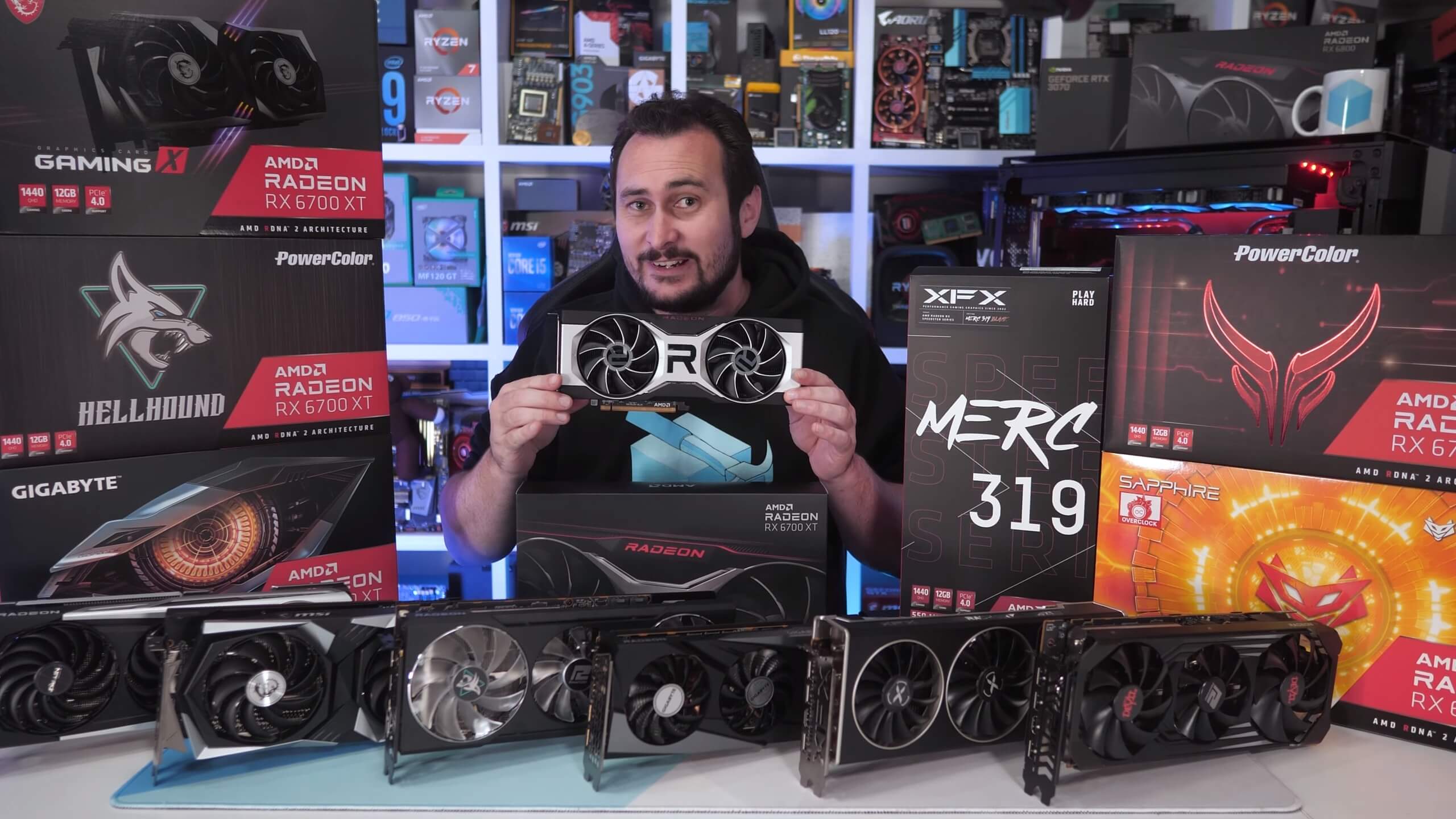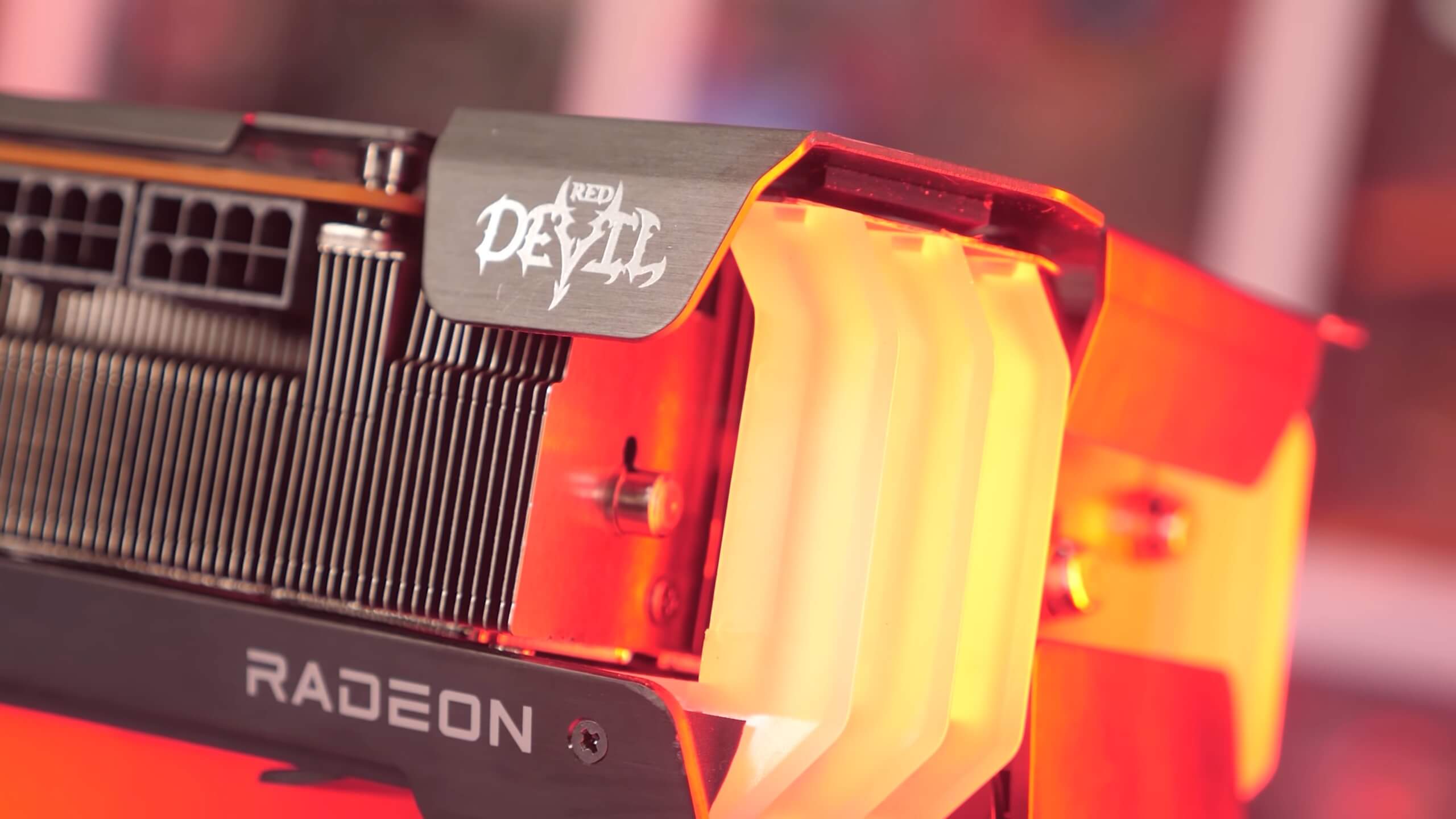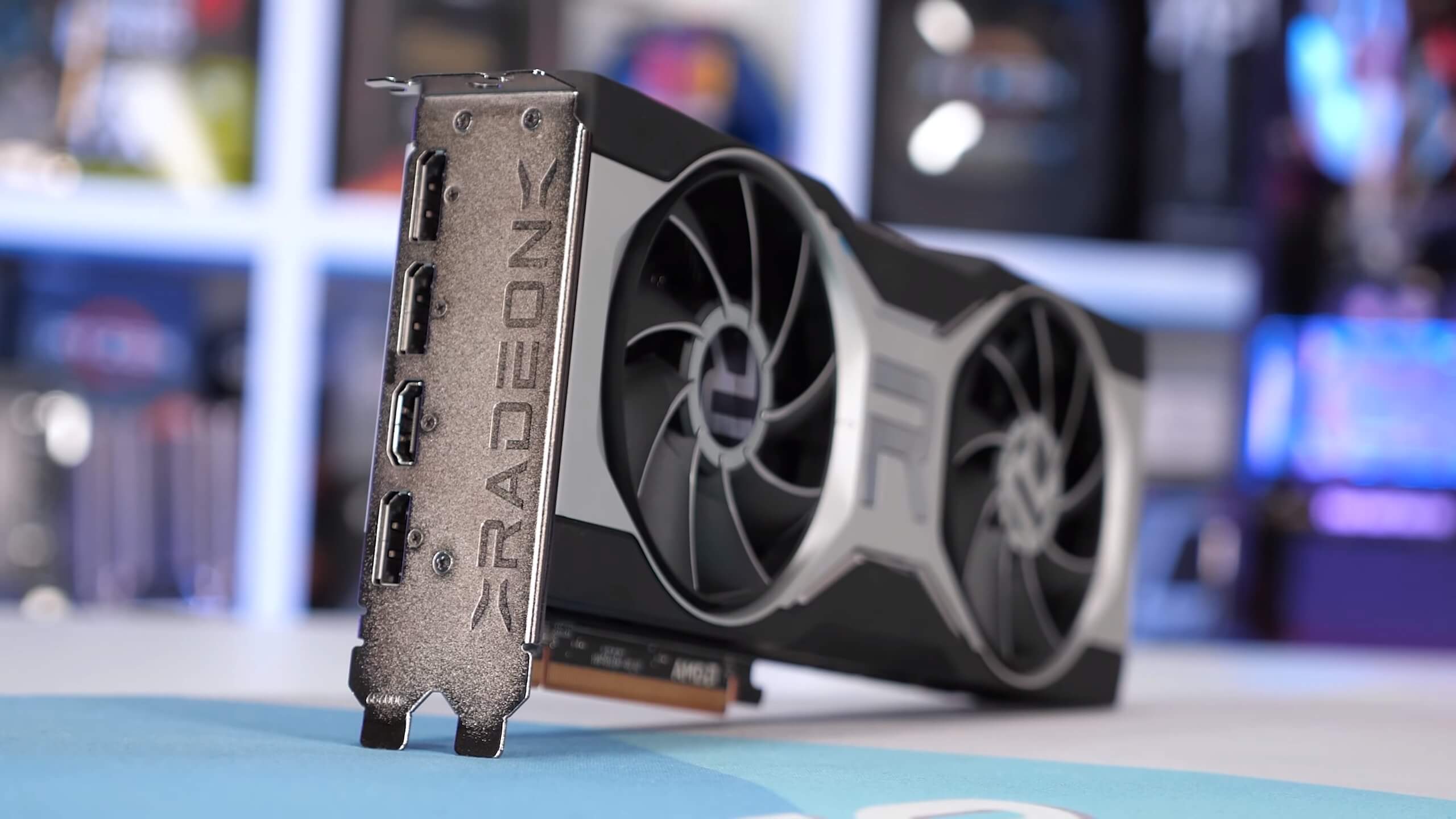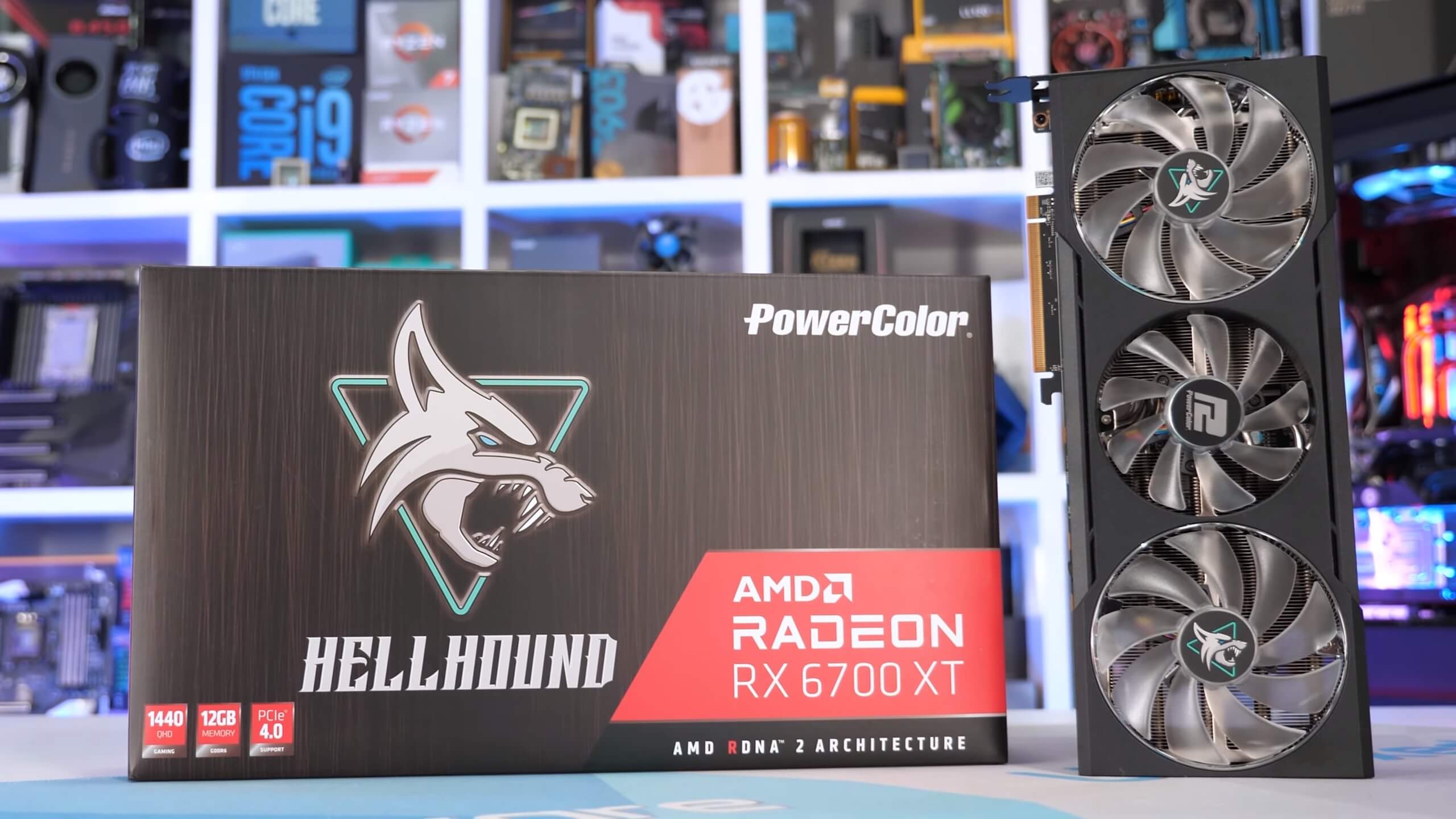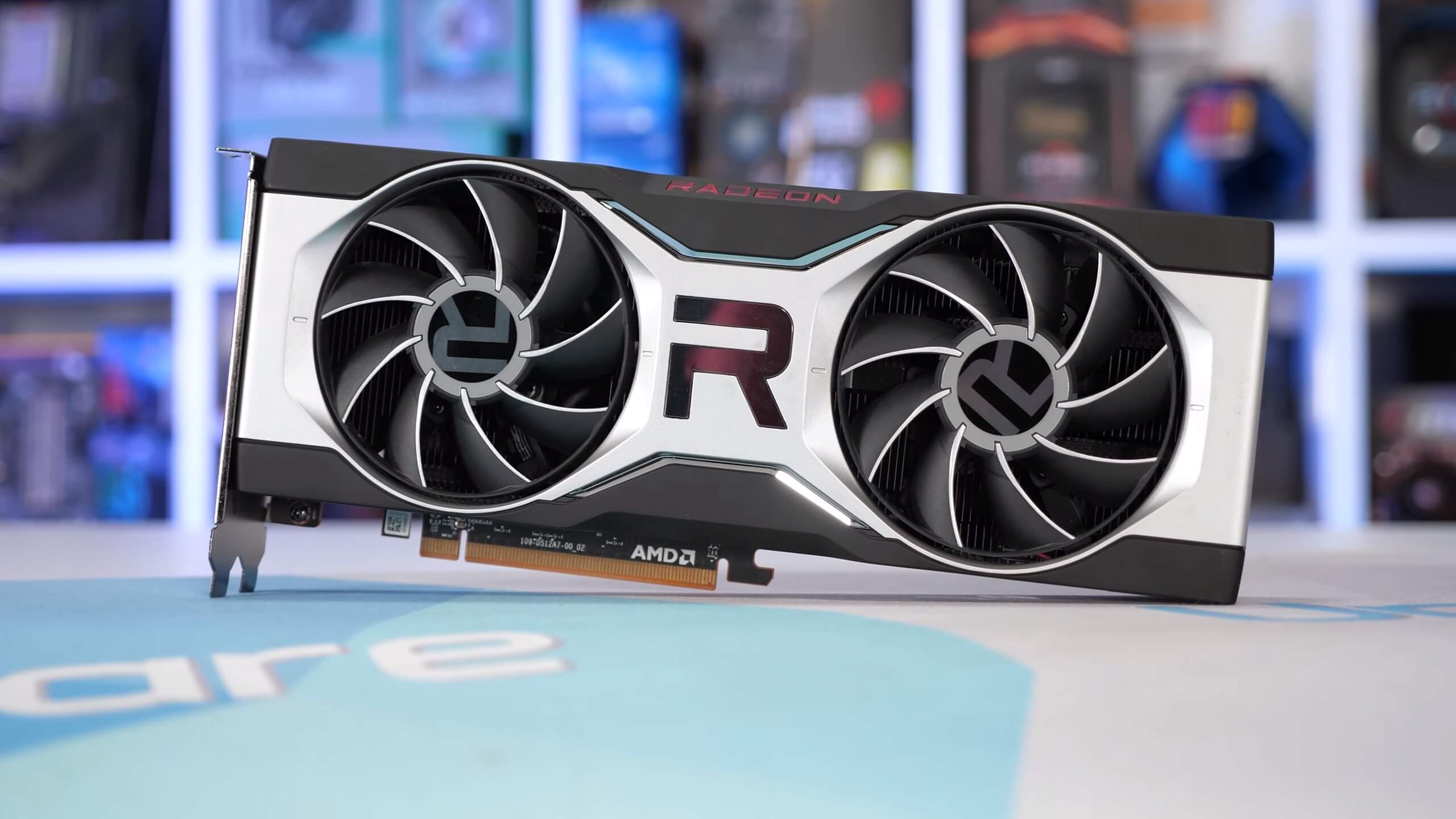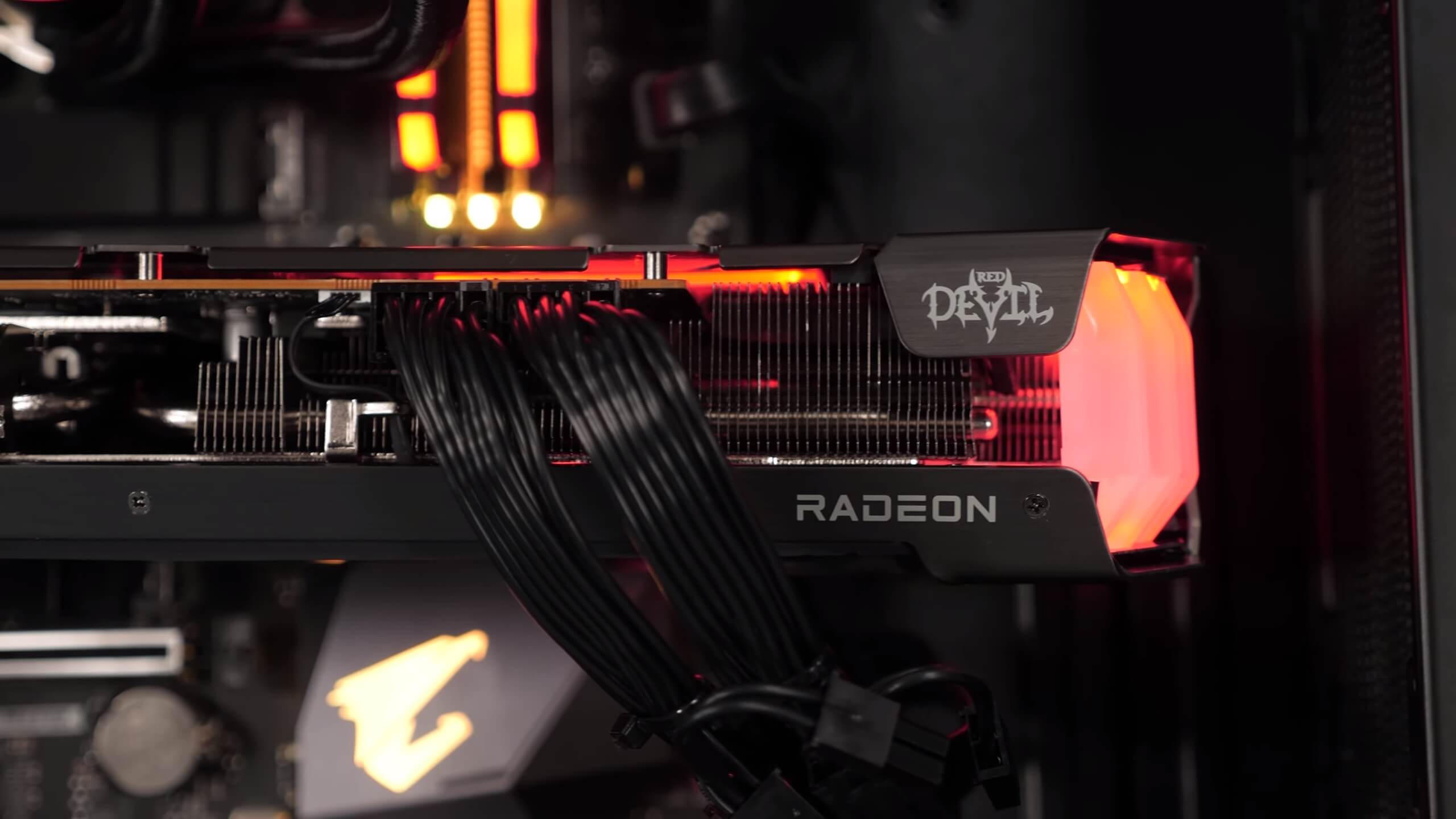[ad_1]
The new Radeon RX 6700 XT arrives with the promise of significantly improved supply when compared to previous Big Navi models which include the RX 6800, 6800 XT and 6900 XT. Targeting the $480 price point, today we’re taking a look at AMD’s board as well as cards from their partners, to see how this cut down RDNA2-based GPU performs.
When compared to the 520mm2 Navi 21 die, Navi 22 which the 6700 XT is based upon is considerably smaller at just 336mm2. That’s a 35% reduction in die size, all manufactured on TSMC’s 7nm process.
When compared to the $580 RX 6800, and yes I’m going to compare the MSRP, the 6700 XT is suggested to be just 17% more affordable which honestly isn’t that significant, particularly given it packs 33% fewer cores, TMUs and ROPs. Moreover, the memory subsystem has also been downgraded as the 192-bit wide bus offers a peak bandwidth of 384 GB/s, a 25% reduction when compared to the 6800.
The smaller bus has also reduced the memory capacity from 16GB to 12GB, which should be a non-issue as this product is targeting 1440p resolutions, and here an 8GB buffer is still sufficient, so 12GB is ample.
So far we’re looking at a substantial 33% downgrade for the core configuration and 25% less bandwidth, all for a ~17% cost saving. Thankfully, the 6700 XT does have one advantage and that comes through clock speed as the cores are clocked 23% higher, so while there are 33% less of them, they should be around 20% faster.
We should also note that the Infinity Cache size has also been reduced by 33% from 128 MB with the 6800, to 96 MB for the 6700 XT. AMD claims that this optimized on-die cache delivers up to 2.5x the bandwidth of a 256-bit wide bus running 12Gbps GDDR6 memory.
Lastly, when compared to the 6800, we’re looking at an ~8% reduction in total board power for the 6700 XT, which makes sense given the cores are clocking higher.
That’s a rough look at the 6700 XT’s specs and how they compare to the next product in the stack. Obviously, with a $480 MSRP, the 6700 XT is targeting the GeForce RTX 3070. AMD has claimed via their own benchmarks, their new GPU is typically faster, but of course that’s using their own cherry-picked range of games. They did throw Watch Dogs Legion in there to make the claim appear more legitimate, but most of the titles were AMD sponsored and are known to perform well on their hardware.
AMD also ran their tests with Smart Access Memory (SAM) enabled, their version of the Resizable BAR PCIe feature. When testing across 35 games at 1440p, we found that SAM boosted performance by 3% on average, though we did see gains of 10% or more in half a dozen titles. SAM also negatively impacted performance by a 3% or greater margin in 5 games we tested.
By default, we don’t test with SAM or Resizable BAR enabled for two reasons: it’s not supported on all platforms, so depending on your motherboard the option may not be supported (AMD still only offers support on 500 series motherboards when using a Ryzen 5000 CPUs or a select 3000 series), and the second reason being that even if you have the required hardware, the feature is not enabled by default, meaning the user needs to enter the BIOS, find the Resizable BAR option and manually enable it.
This isn’t that different from what we do with XMP, but it’s another step that we’d be making only to enhance the performance of Radeon GPUs, so for now we’re not going to do that. We do intend to provide some SAM-enabled results however, showing where it works well and where it doesn’t.
For testing, we’re using our Ryzen 9 3950X test system as we’re still in the process of updating to the 5950X, expect all that data once we get through this latest round of product releases. This system is configured with 32GB of dual-rank, dual-channel DDR4-3200 CL14 memory.
In this review we’ll focus on 1440p data for most of the games we tested before jumping into the usual performance breakdown graphs, which will include a look at 1080p as well. Let’s get into the results…
Benchmarks
First up we have the Watch Dogs Legion data and here the 6700 XT is 11% slower than the RTX 3070 and just 2% faster than the RTX 3060 Ti, so in other words, we’re looking at 3060 Ti performance in this title which doesn’t bode well for AMD given the 6700 XT costs 18% more.
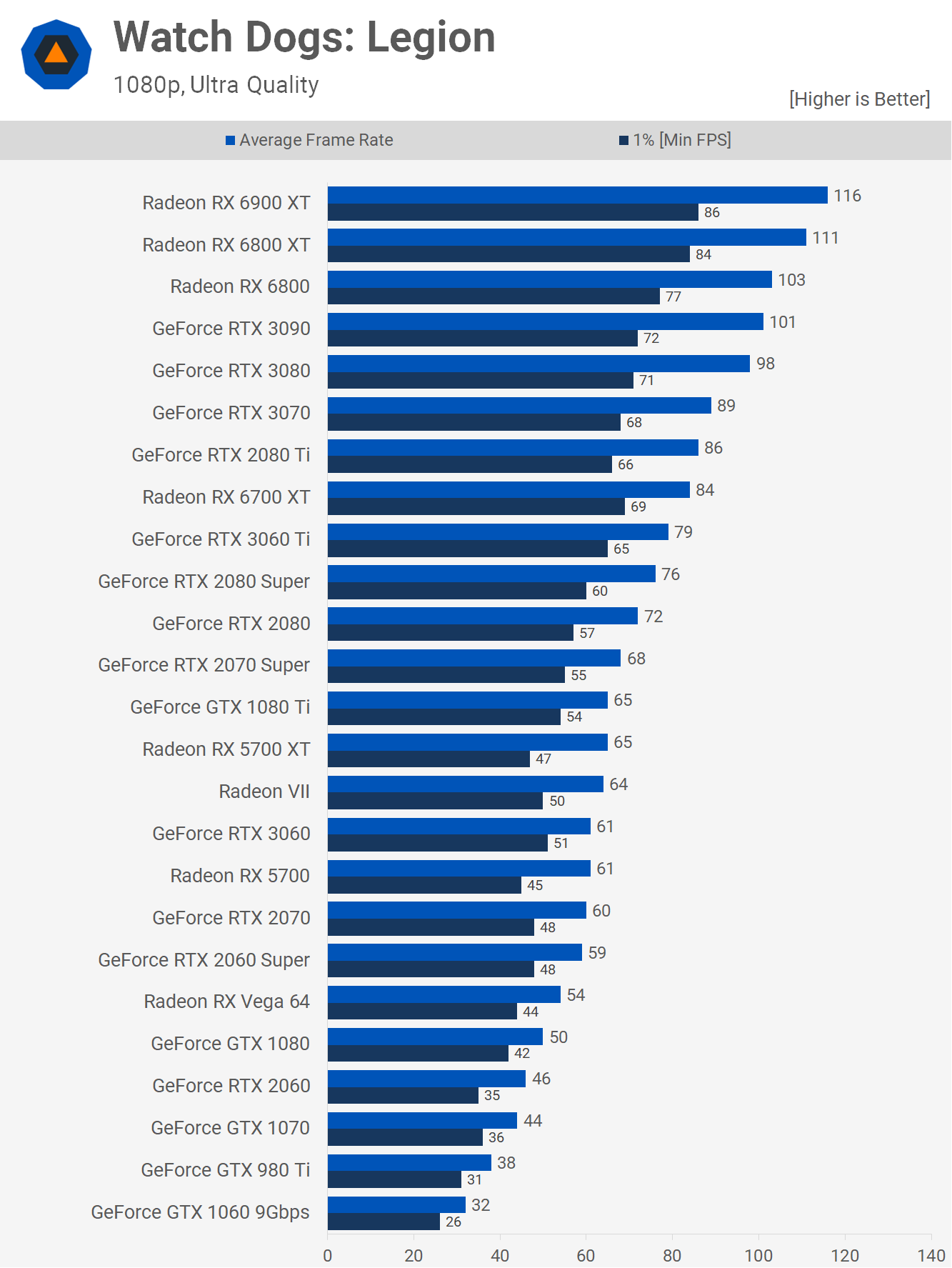
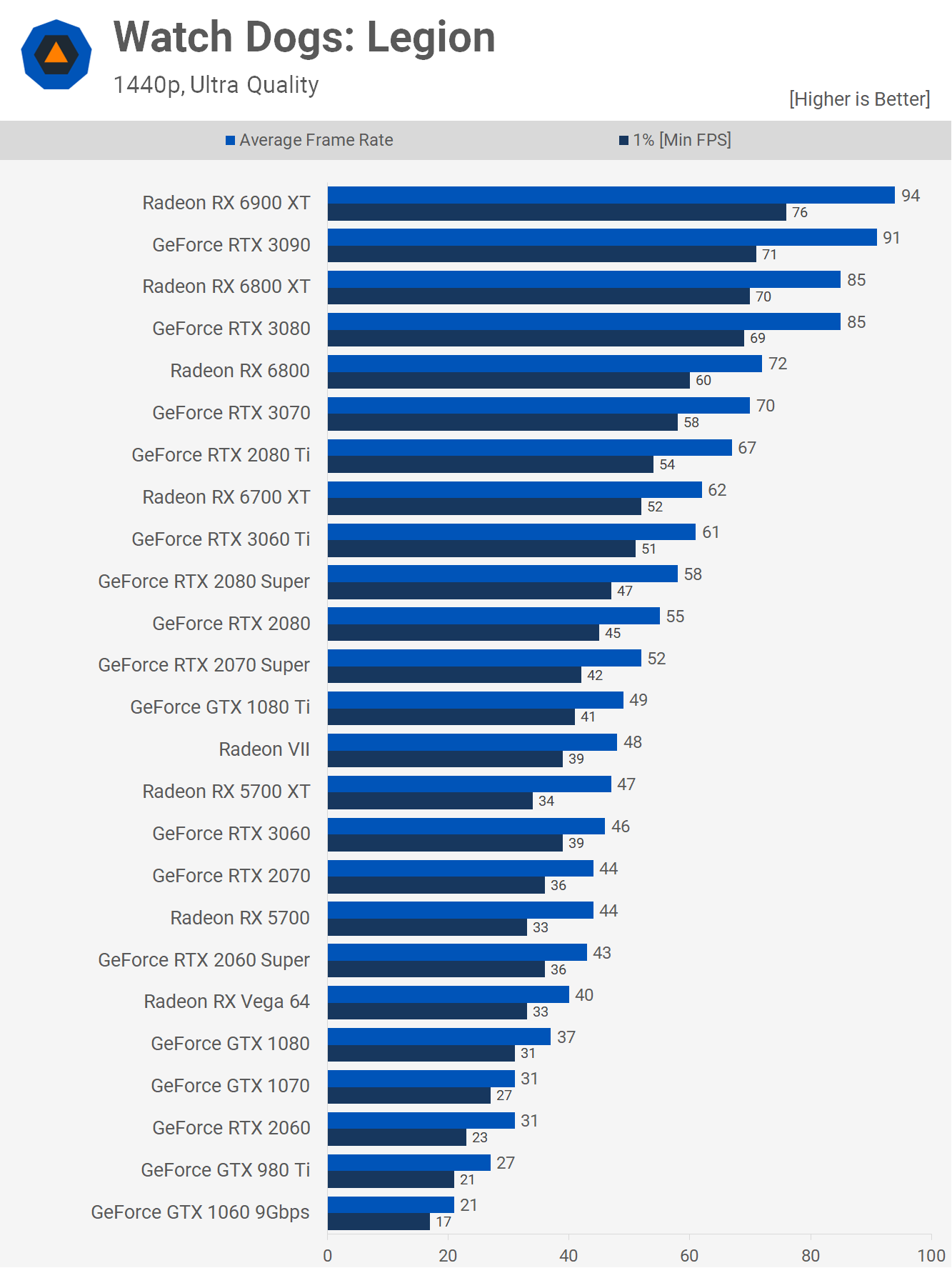
That said, it is only 14% slower than the RX 6800 and that’s a good result as it means we could be looking at impressive performance in AMD-optimized titles, such as Assassin’s Creed Valhalla. Speaking of which…
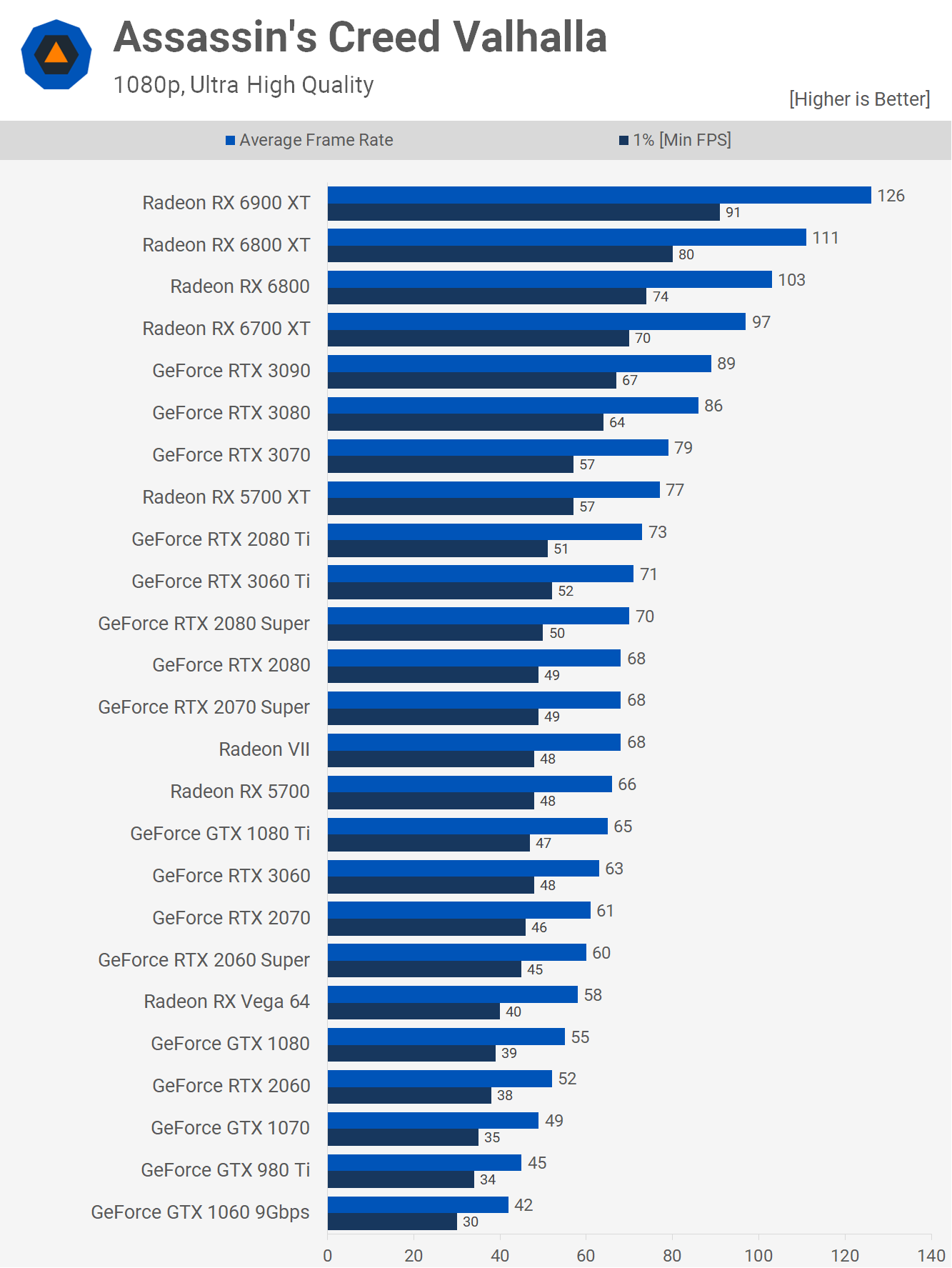
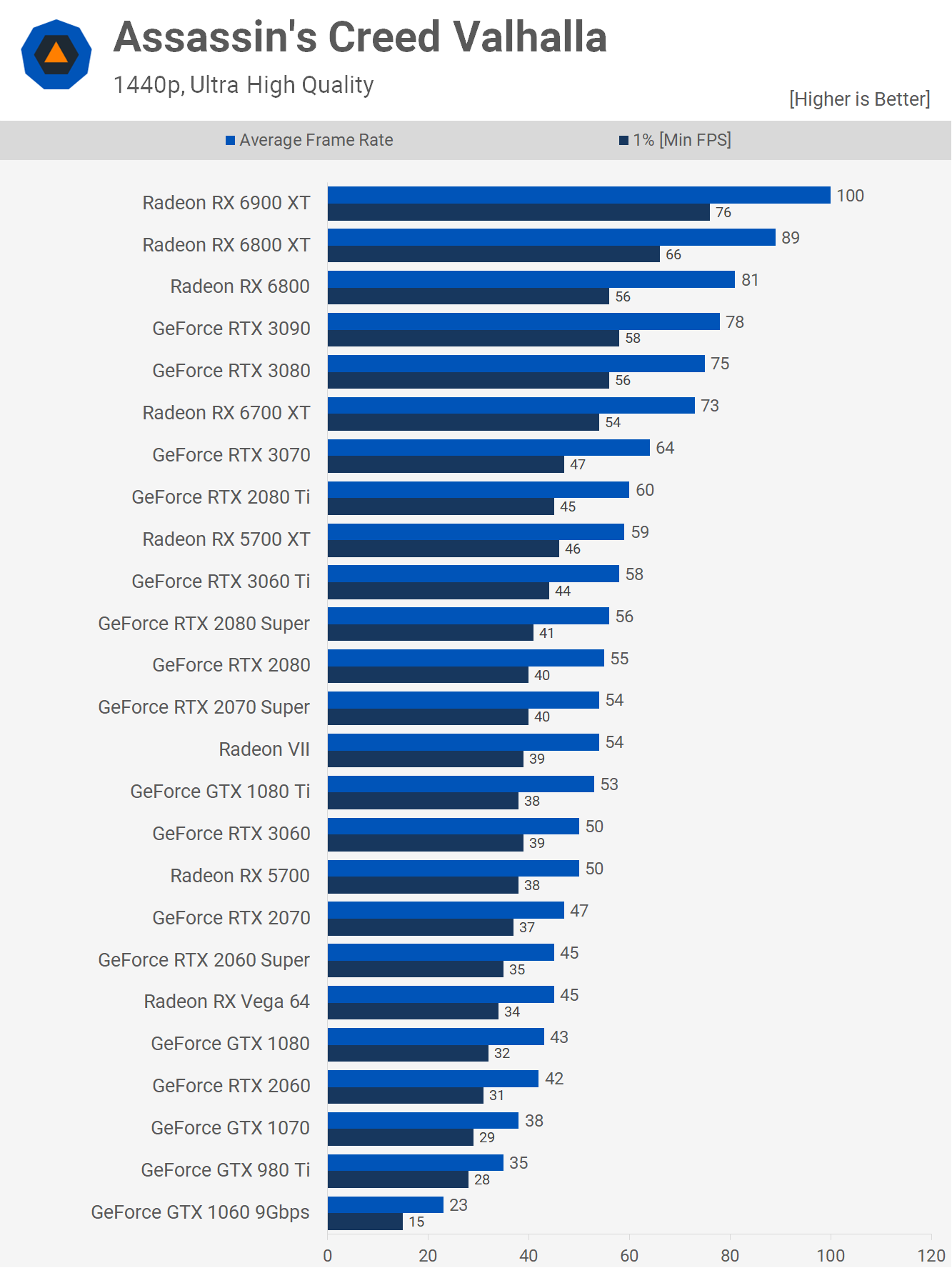
As expected the Assassin’s Creed Valhalla performance looks impressive, hitting 73 fps on average at 1440p using the highest quality preset. That makes it just 10% slower than the RX 6800 and 14% faster than the RTX 3070.
This is a great result though I couldn’t help but notice the 6700 XT is just 24% faster than the 5700 XT. While that’s a decent performance uplift, remember it’s coming at a 20% premium, at least when comparing the MSRP.
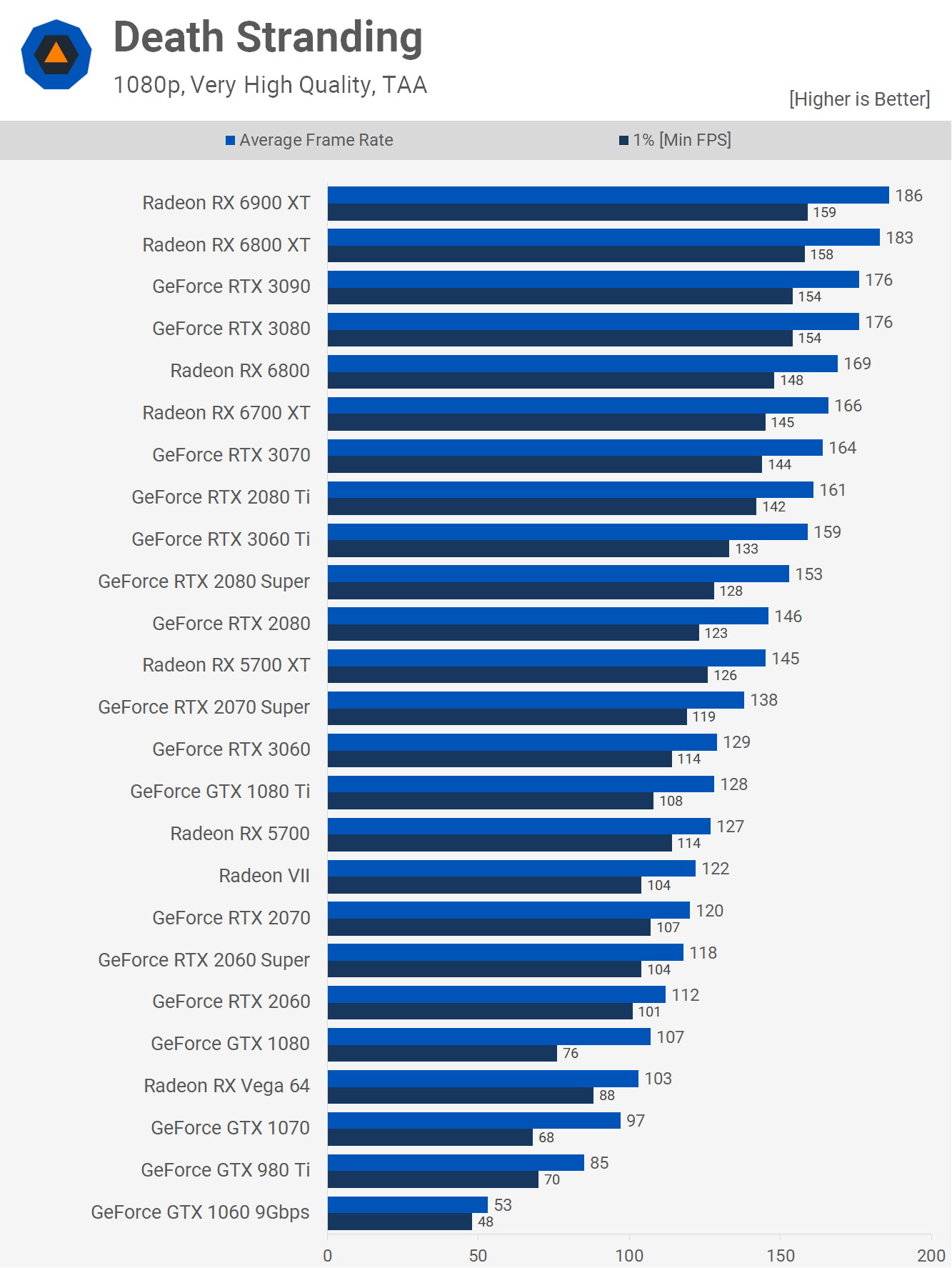
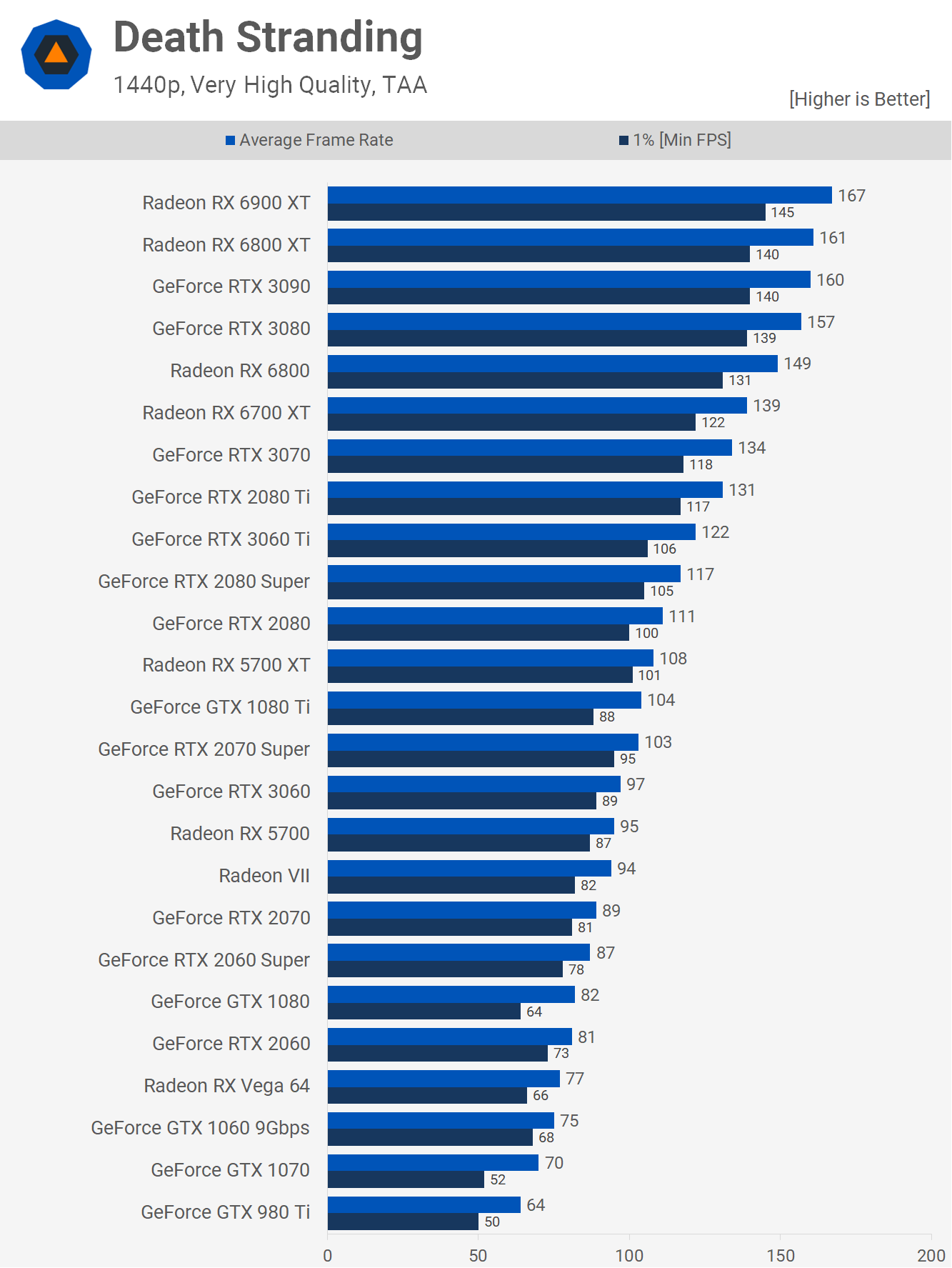
The 6700 XT performs well in Death Stranding, edging out the RTX 3070 by a slim 4% margin, so basically identical performance between the two competing GPUs. Quite surprisingly, the 6700 XT is just 7% slower than the RX 6800, we are likely running into a slight CPU bottleneck here with the 3950X which will be resolved with the updated 5950X test system, but I don’t expect this margin to grow beyond a few percent.
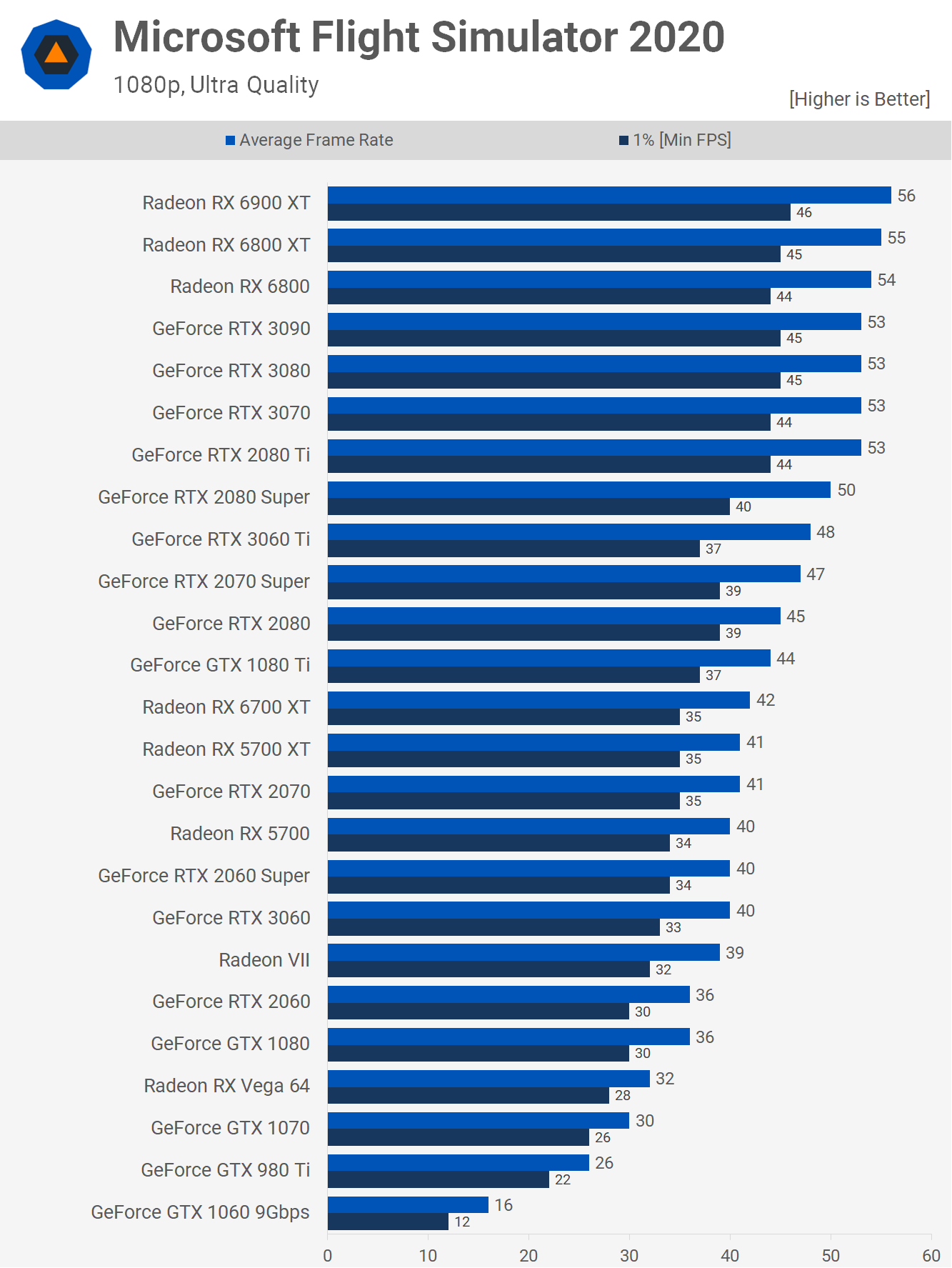
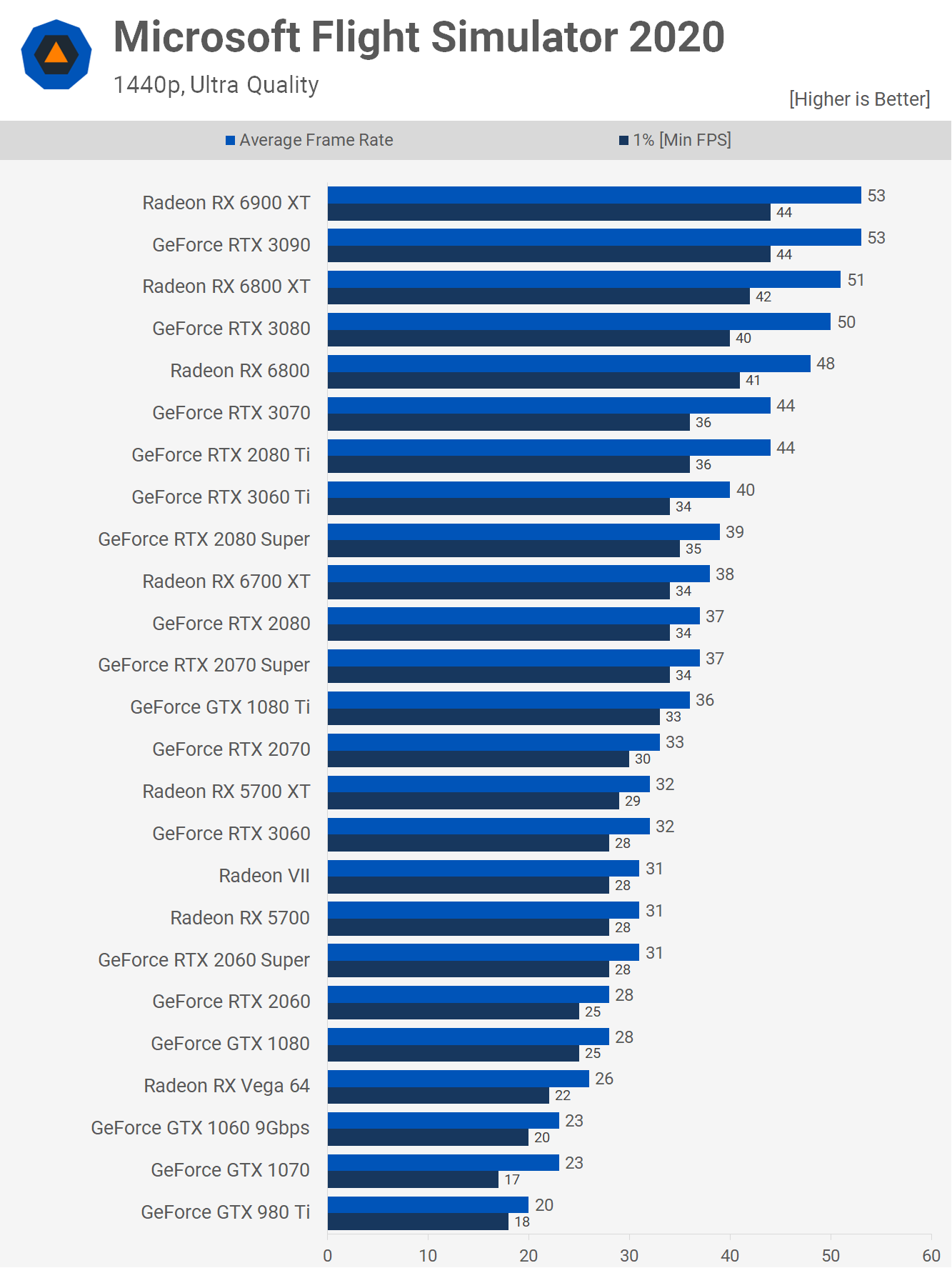
Moving on to Microsoft Flight Simulator 2020, we find that the 6700 XT isn’t all that impressive here, trailing the 6800 by a 21% margin as it drops down from 48 fps to just 38 fps. That means it’s also 14% slower than the RTX 3070 and even 5% slower than the 3060 Ti. Perhaps even more disappointing was that it’s just 19% faster than the 5700 XT.
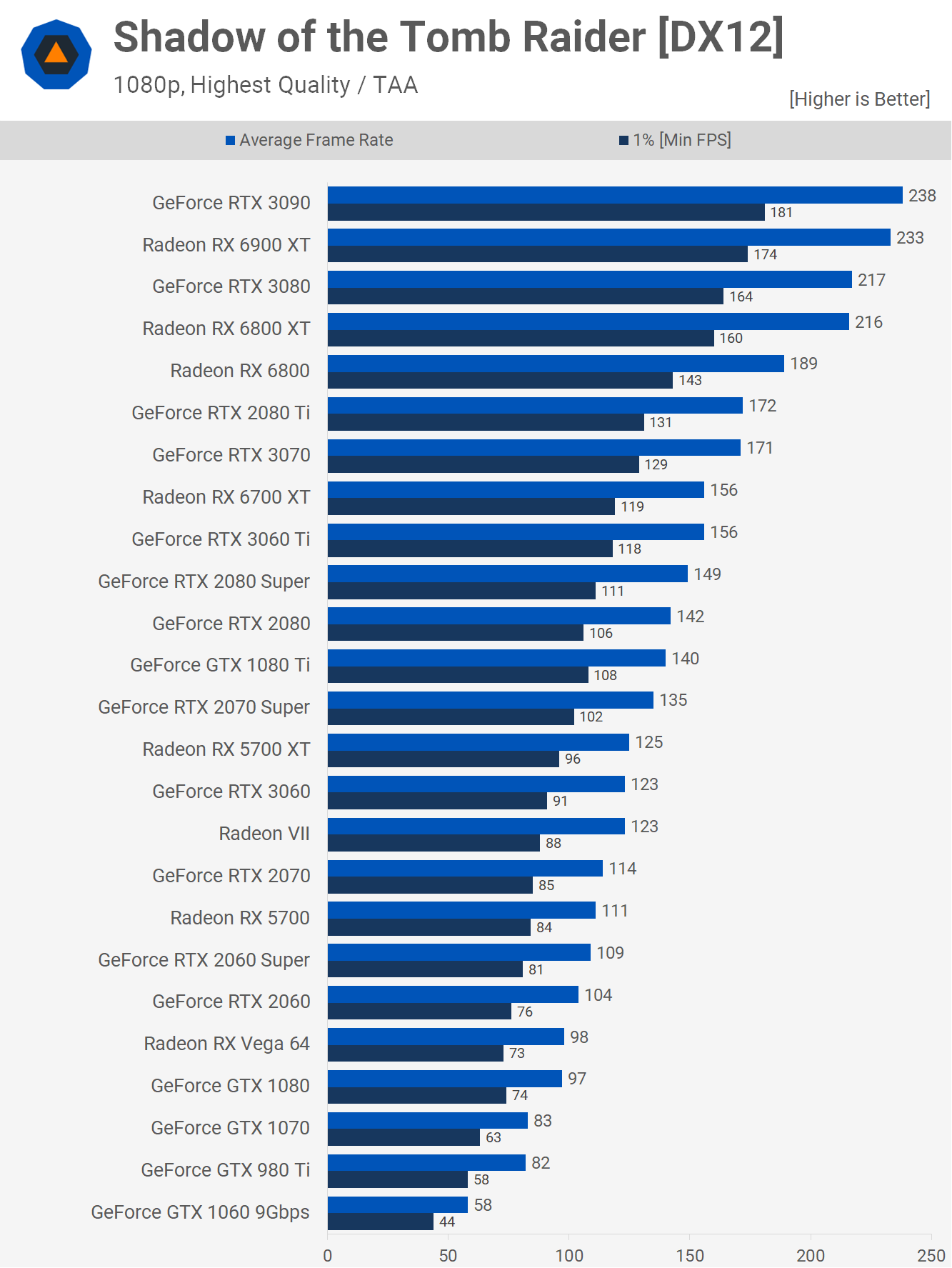
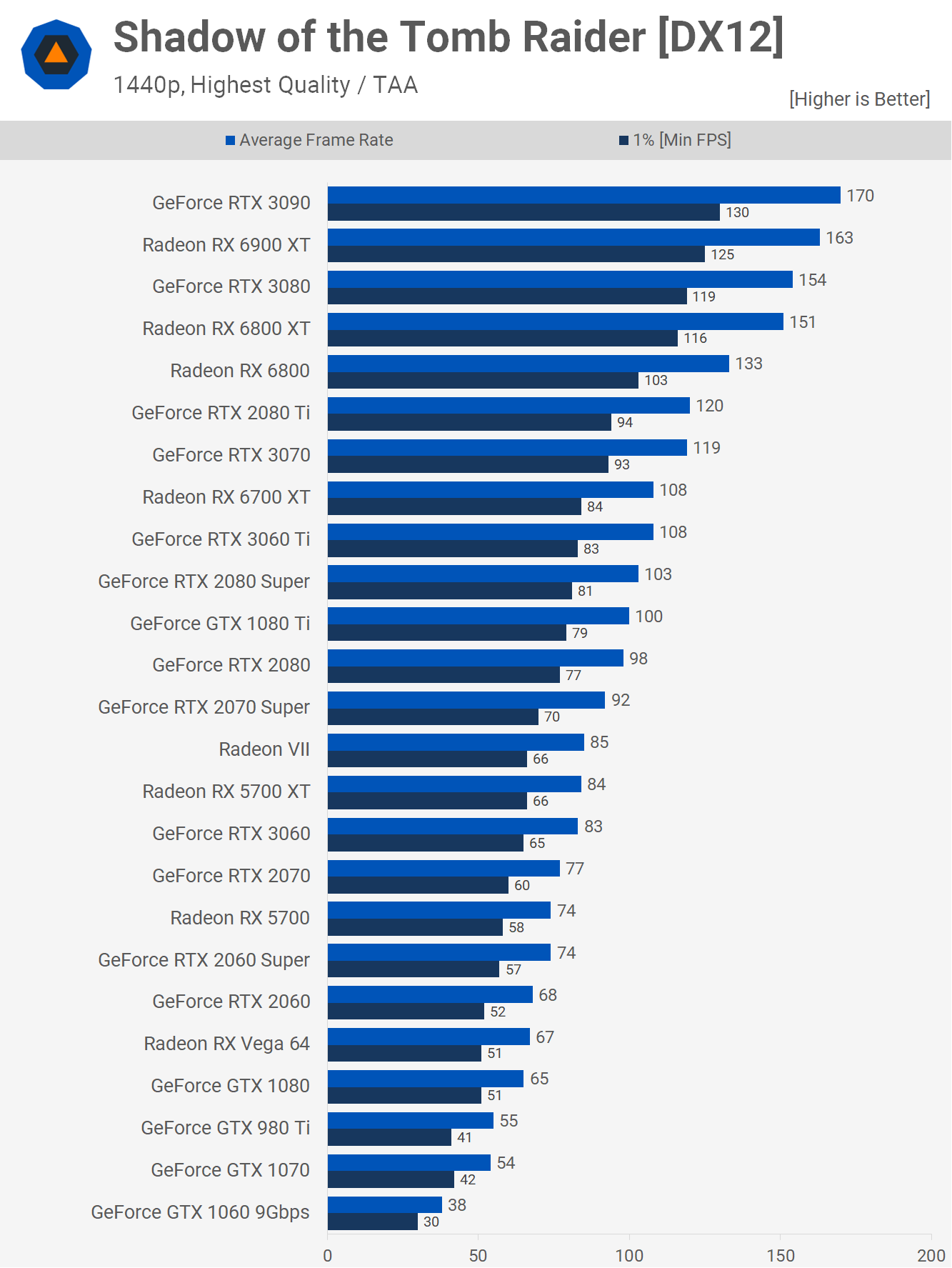
Performance in Shadow of the Tomb Raider is also disappointing. Here the 6700 XT is only able to match the cheaper RTX 3060 Ti, making it 9% slower than the RTX 3070 and 19% slower than the 6800. It does offer nearly 30% performance than the old 5700 XT.
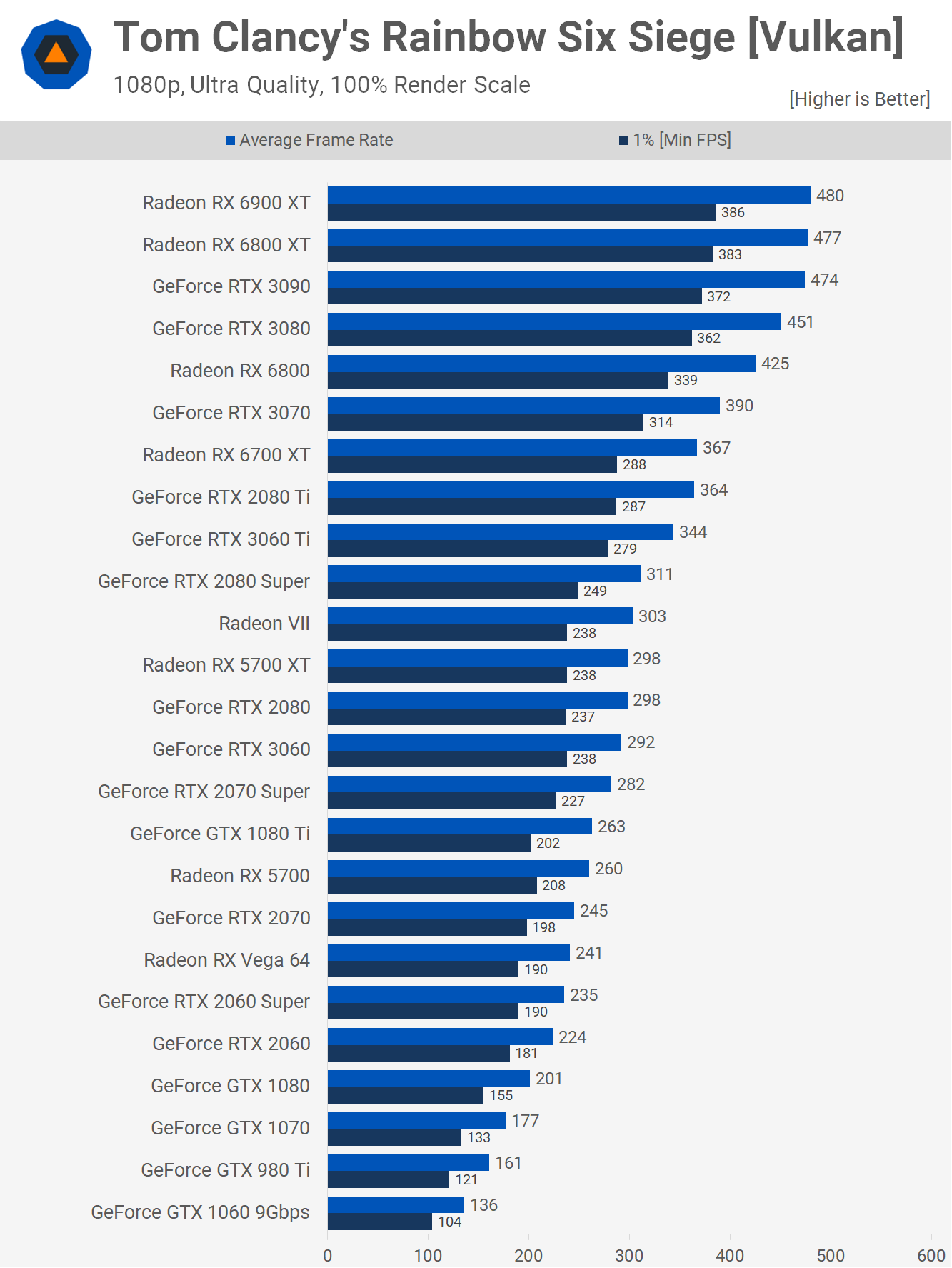
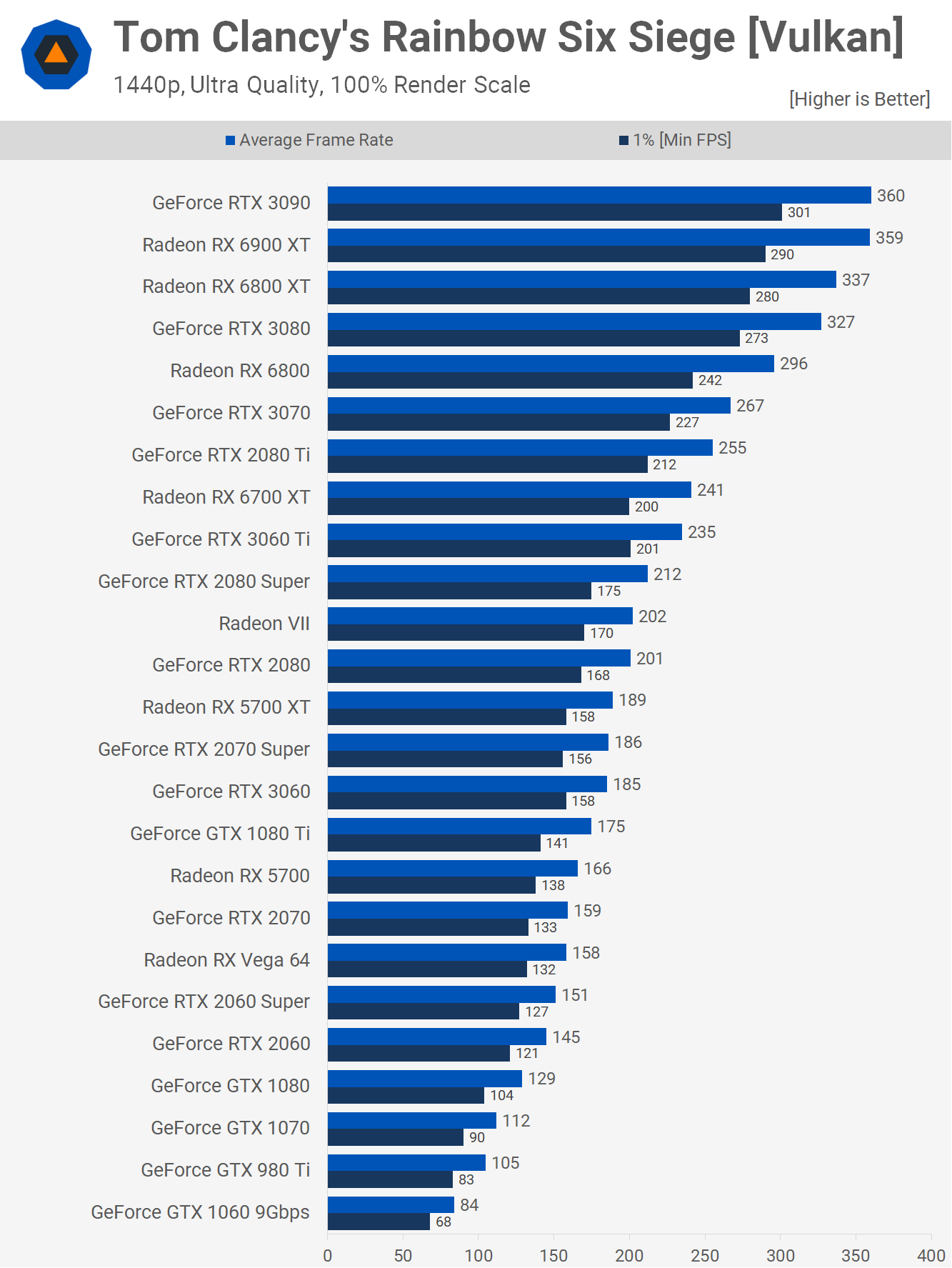
The 6700 XT also struggles to keep pace with the RTX 3070 in Tom Clancy’s Rainbow Six Siege, this time it’s 10% slower and again was more comparable with the 3060 Ti, beating it by a mere 2.5% margin. When compared to the RX 6800, we’re looking at a 19% performance loss and when compared to the 5700 XT, a 28% performance gain.
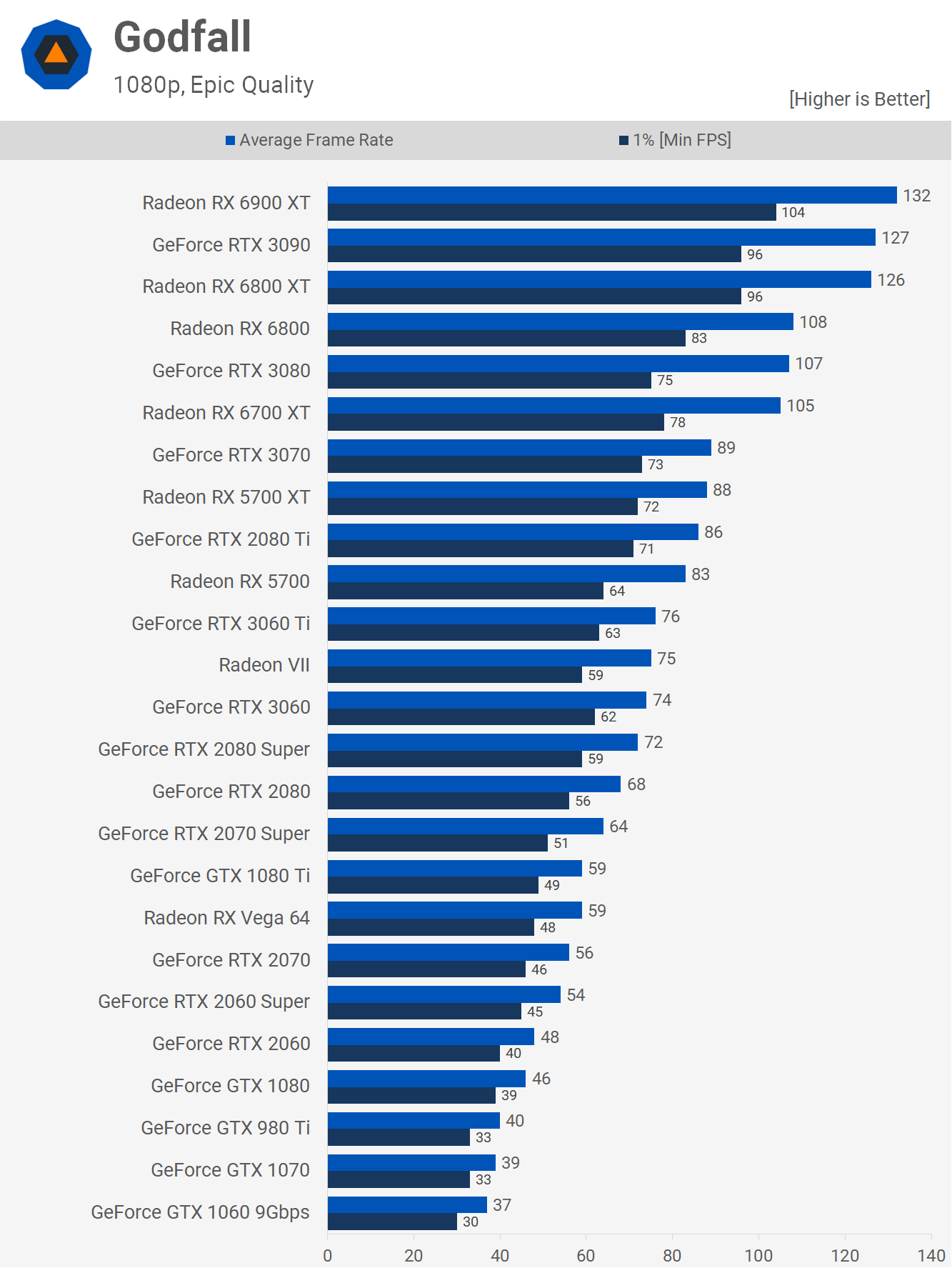
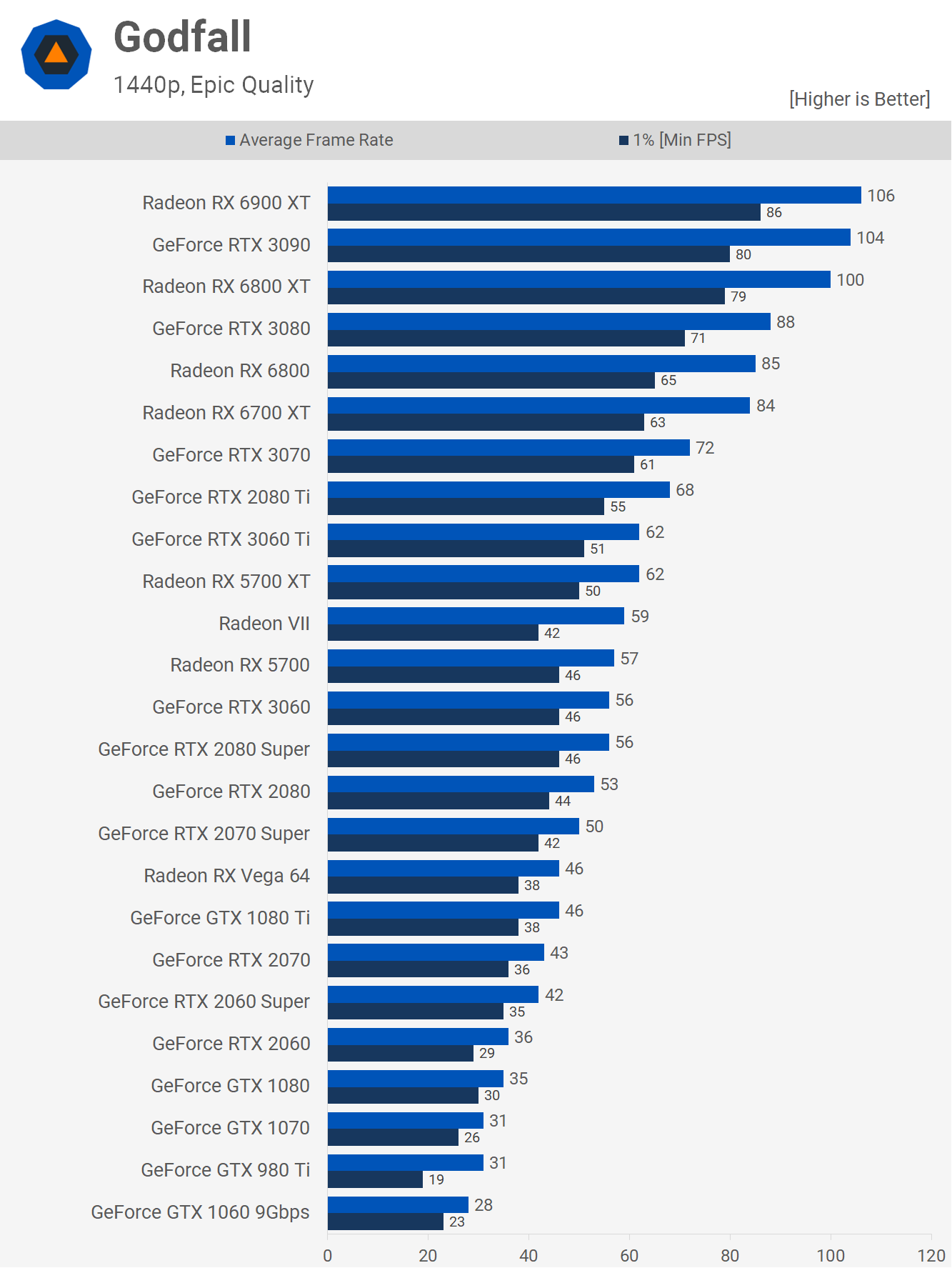
Godfall is an AMD-sponsored title that’s well-optimized for Radeon GPUs. As a result, the 6700 XT is able to blow away the RTX 3070, offering 17% greater performance at least when comparing the average frame rate. The 1% low performance was actually very similar.
Interestingly, the 6700 XT minced the performance of the RX 6800 in this title and after multiple re-tests, we received the same results. Do note that we went back and retested the 5700 series GPUs and found that performance had improved since our previous testing a few months ago.
The 5700 XT is now on par with the RTX 3060 Ti and that means the 6700 XT is 35% faster, which is a much larger performance uplift than we’ve seen in other titles.
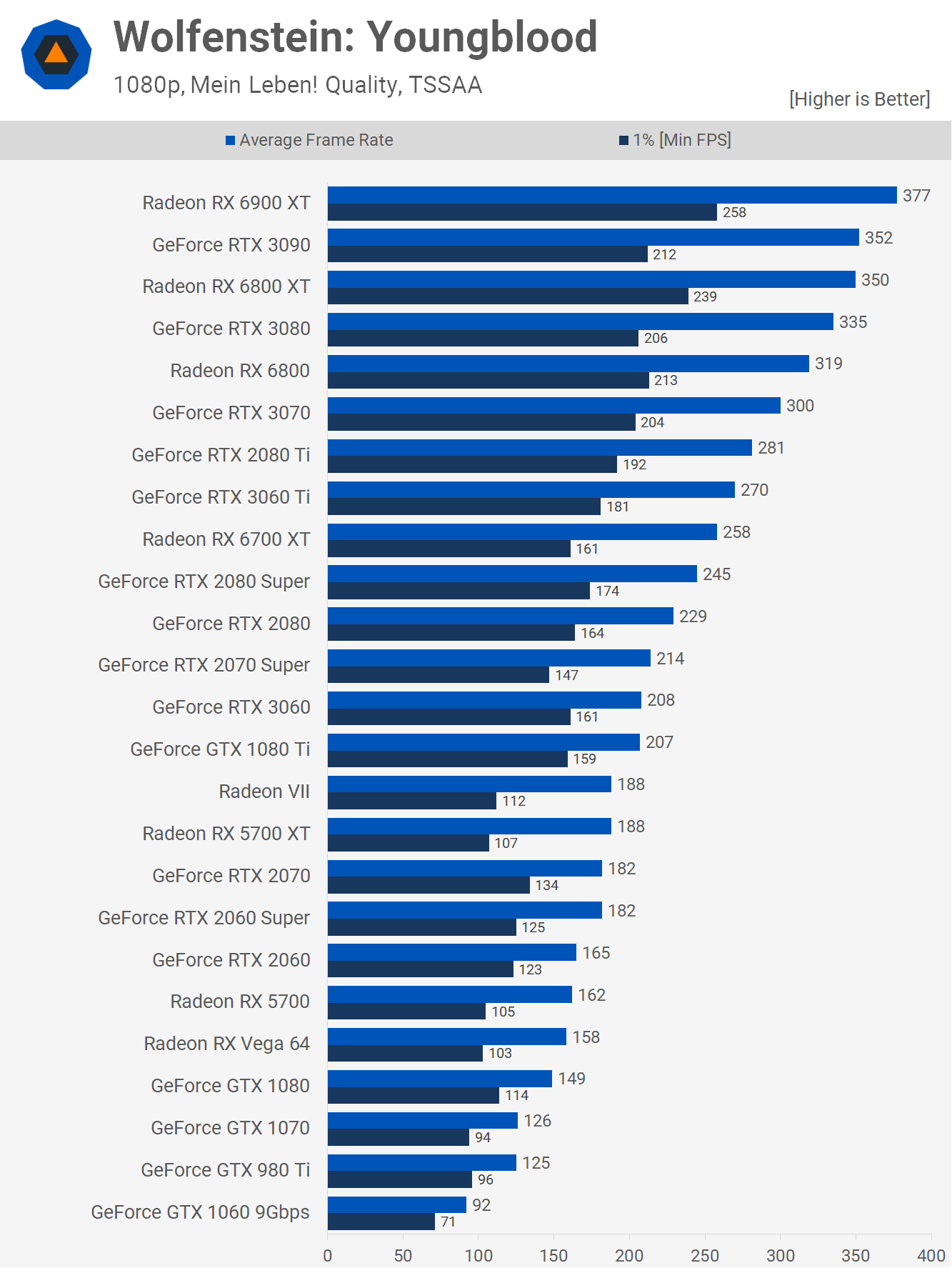
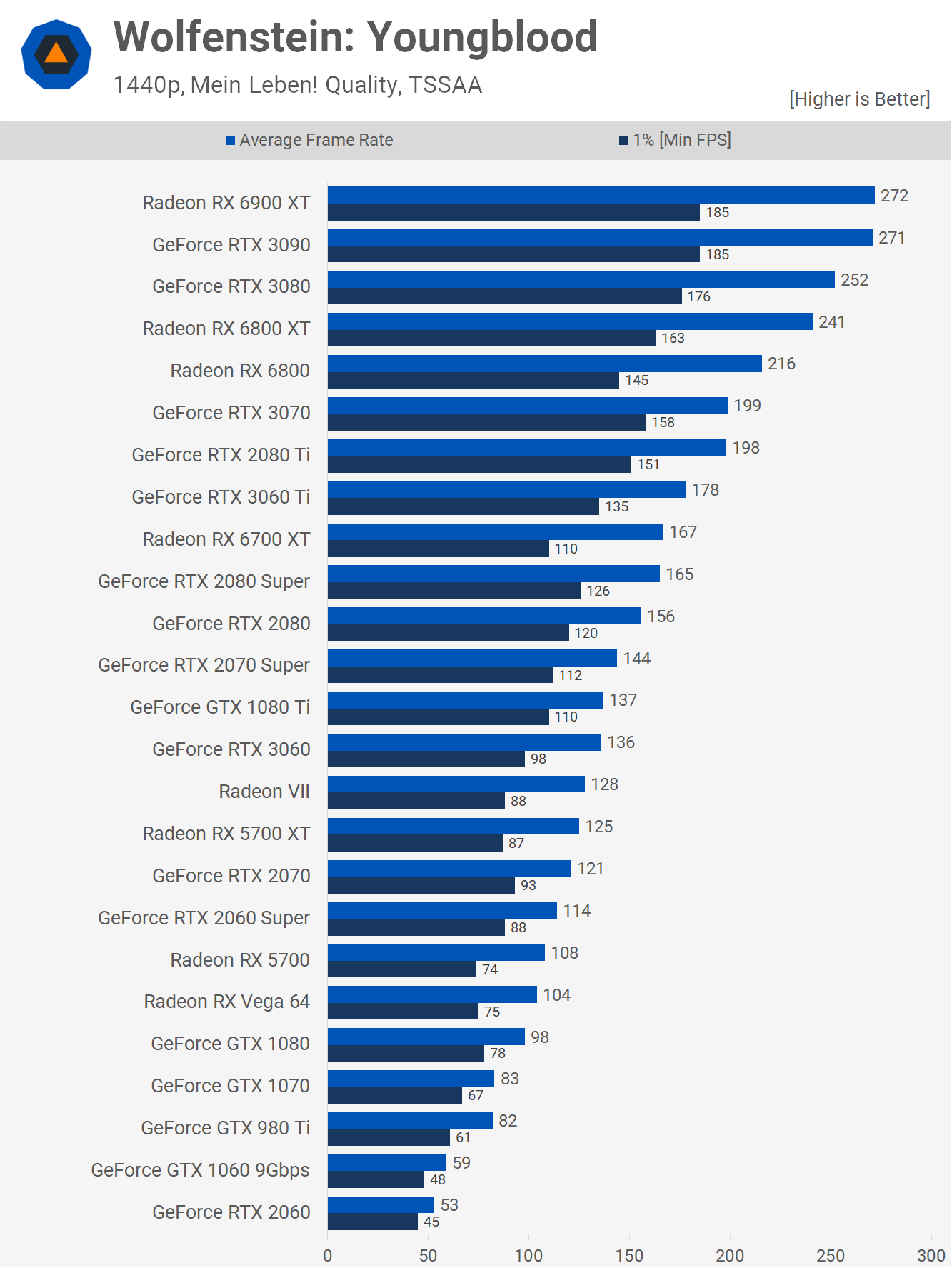
Now here’s a look at performance in a title sponsored by Nvidia. Wolfenstein Youngblood doesn’t let the 6700 XT have its best showing, losing to the RTX 3070 by a 16% margin and even the 3060 Ti by a 6% margin. It’s also 23% slower than the 6800, though it was 34% faster than the 5700 XT, so a pretty good result relative to the older Radeon part.
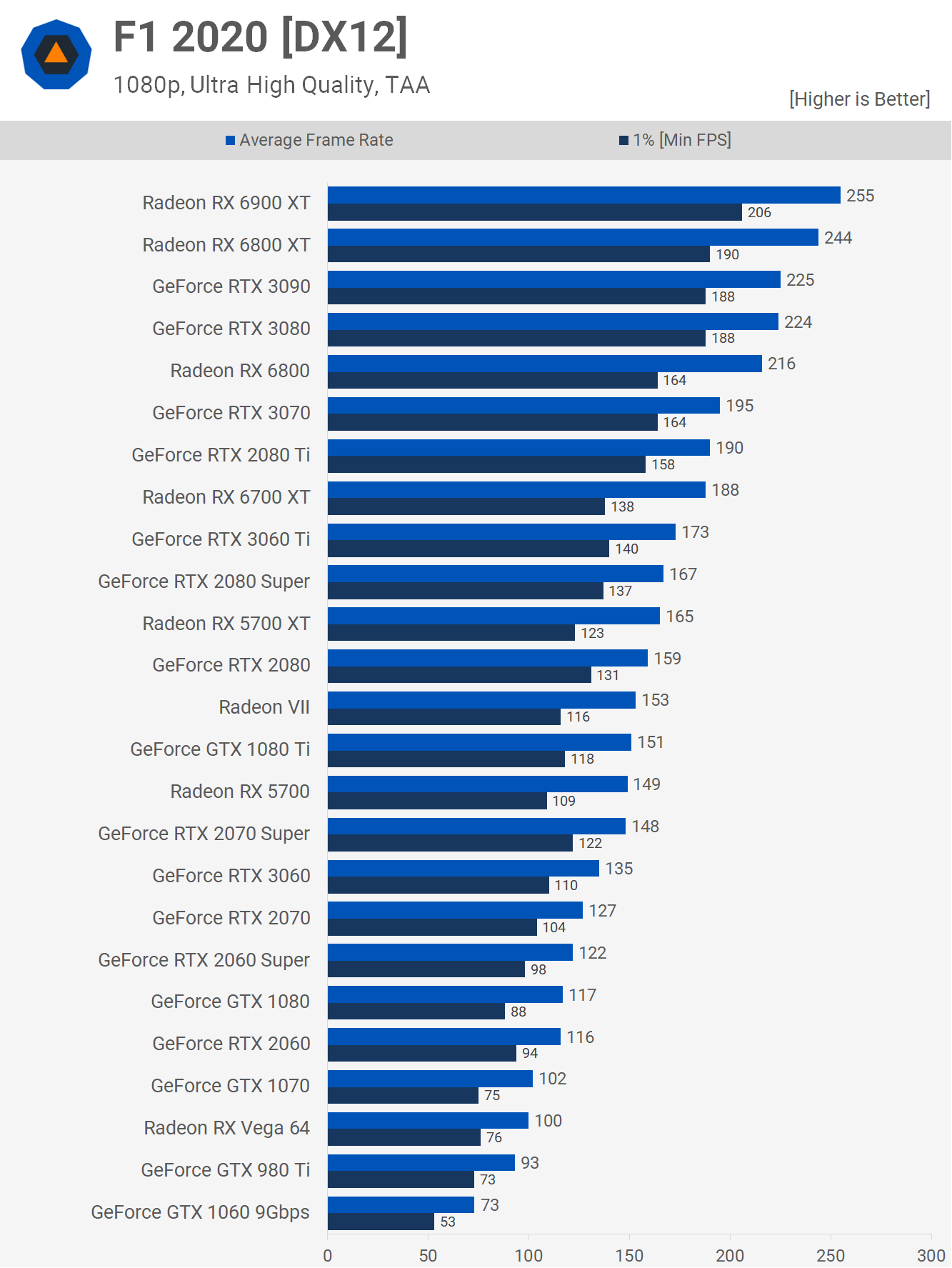
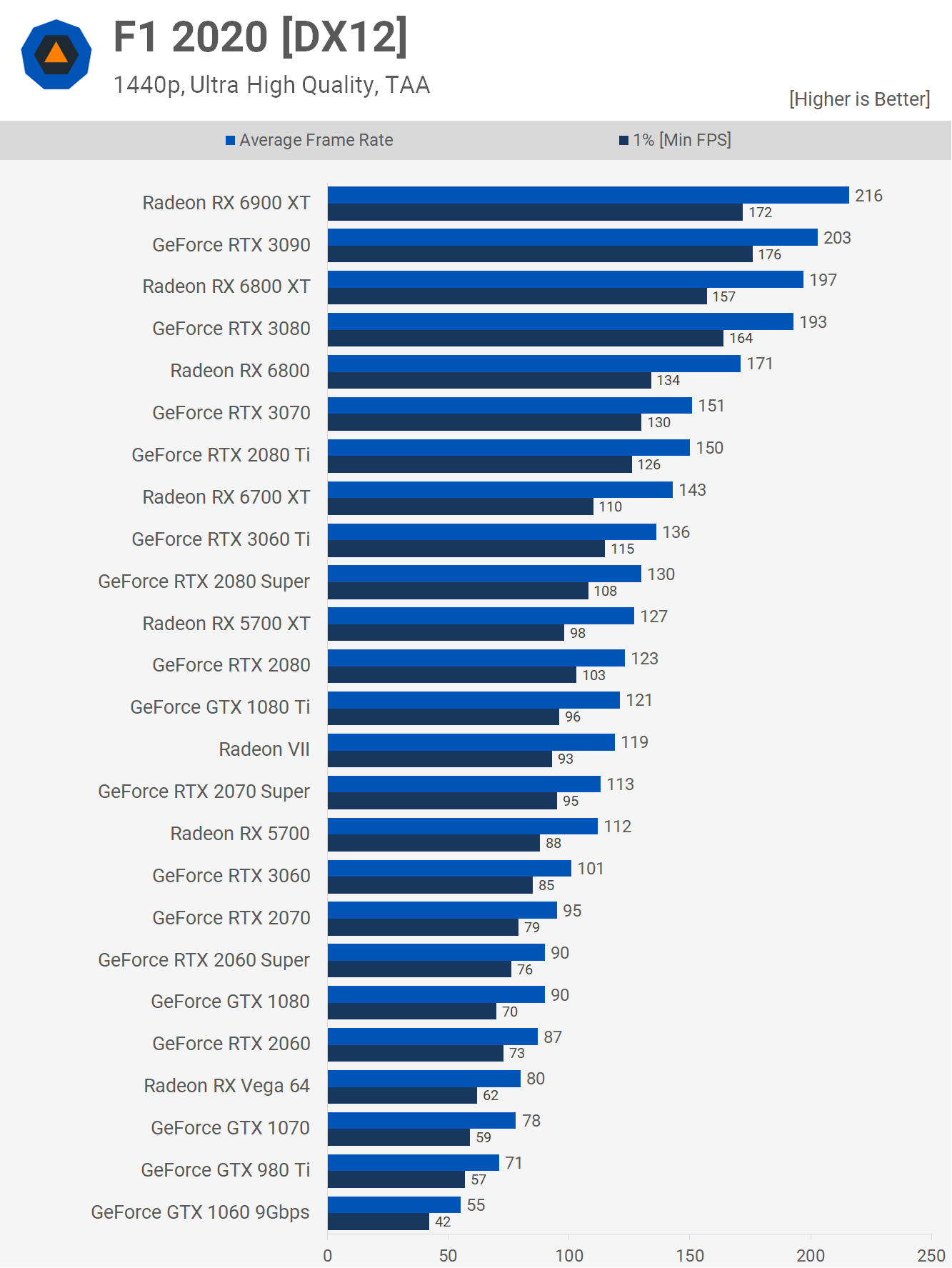
The F1 2020 results are quite disappointing, especially considering how well other Radeon GPUs perform. The 6900 XT can be seen beating the RTX 3090, the 6800 XT can beat the RTX 3080, and the 5700 XT easily beat the RTX 2060 Super.
The 6700 XT, on the other hand, is 5% slower than the RTX 3070. While that’s a fairly insignificant margin, when compared to how the other Radeon GPUs stack up, it’s not great. It also means the 6700 XT is a mere 13% faster than the 5700 XT in this racing title.
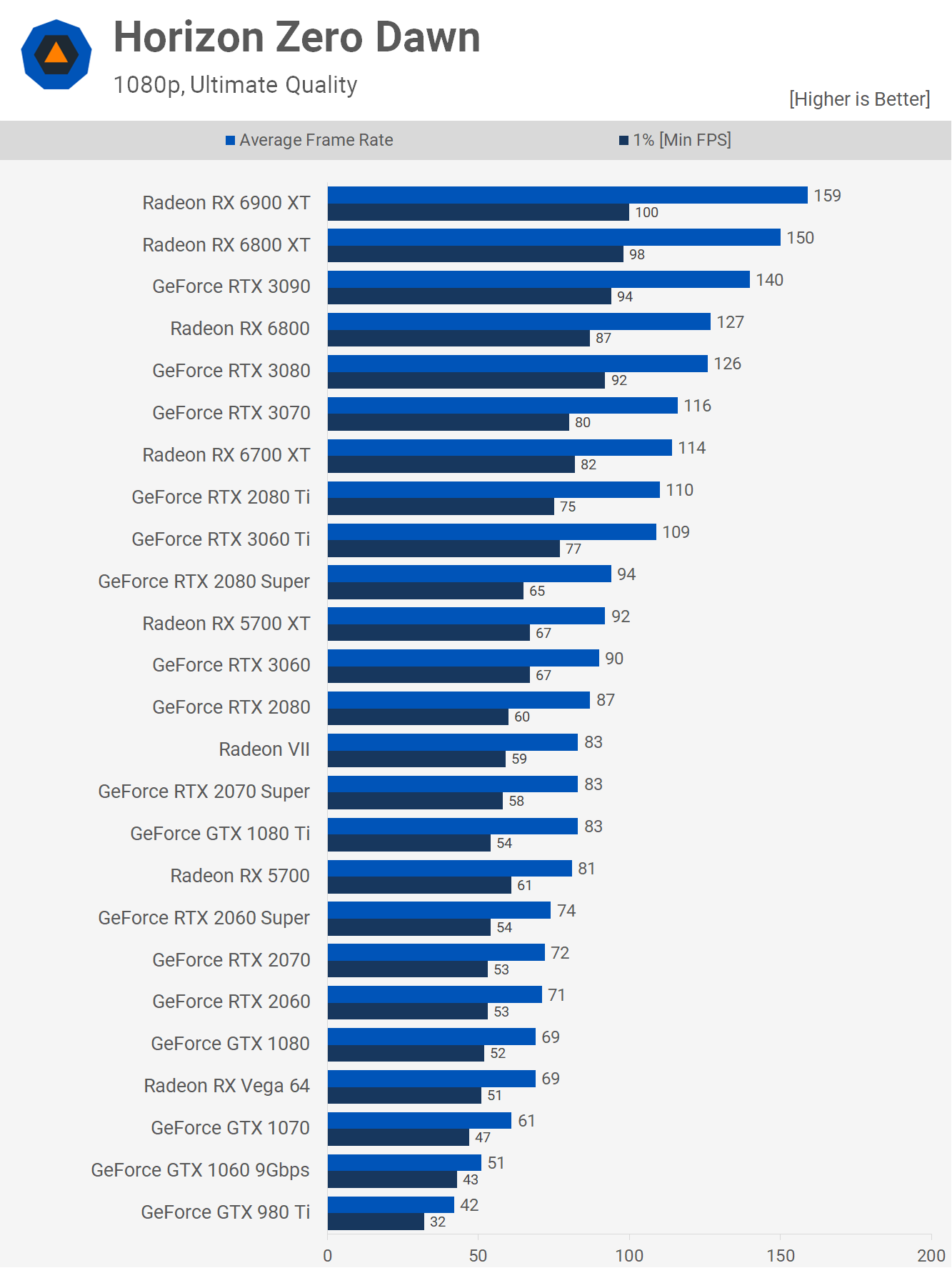
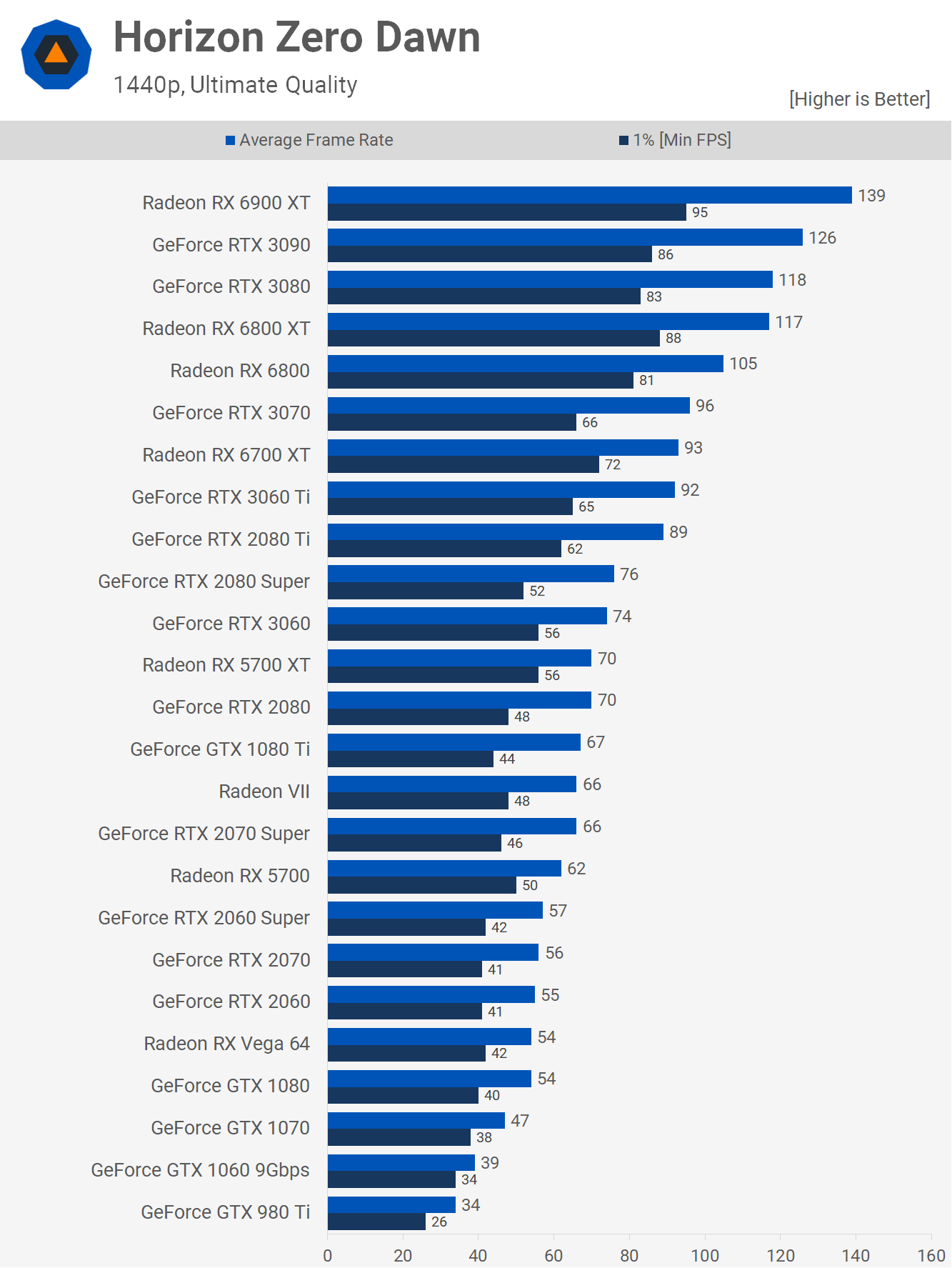
In Horizon Zero Dawn the 6700 XT finds positioned squarely between the RTX 3070 and 3060 Ti, but they’re all so close it doesn’t really matter, so let’s call this one a tie. The 6700 XT is just 11% slower than the 6800 and 33% faster than the 5700 XT, so when compared to other Radeon products that’s a decent result.
Average Gaming Performance
First here’s a look at the 1080p data, averaged across our 14 game sample. At this entry-level resolution, the 6700 XT averages 150 fps, meaning it’s 3% slower than the RTX 3070.

Had we enabled SAM for what would probably be a 3% boost, performance would be identical, though you could get a similar boost by enabling DLSS 2.0 in the games that support it. When compared to the cheaper RTX 3060 Ti, we’re looking at just a 6% performance boost and then just a 23% increase over the 5700 XT while it was just 12% slower than the RX 6800, though again note some CPU limitations will be present in this low-resolution data.

Jumping to 1440p we find that the 6700 XT is 4% slower than the RTX 3070 and just 6% faster than the RTX 3060 Ti. This time it was 16% slower than the RX 6800 and a much more impressive 30% faster than the 5700 XT, though again it also costs 20% more, so a pretty uninspiring improvement.
Cost per Frame
Now for a look at cost per frame, and obviously this time we can’t include eBay pricing data as we did in the RTX 3060 review as this review isn’t being published 2 weeks after release. For now here’s an MSRP comparison as that’s the only meaningful comparison we can make at this time.

In terms of value, the Radeon 6700 XT is a minor improvement over the RX 6800, and that means the RTX 3070 and in particular the RTX 3060 Ti are better value. You’re looking at a 14% discount per frame with the RTX 3060 Ti, for example, which doesn’t bode well for AMD as they’re essentially occupying the same performance tier.
Though perhaps the most disappointing comparison that can be made is with the 5700 XT. A 7% improvement in cost per frame after two years is not great. At $400, the 6700 XT would be a 23% improvement in cost per frame, and we think that would have been an amazing result, though it’s also extremely wishful given the current climate.
Ray Tracing Performance
Before wrapping up, we still have to take a quick look at ray tracing and DLSS performance, along with power consumption and overclocking. We’ll also compare a few of the AIB models we have on hand in terms of clock speeds and thermals.
For testing ray tracing we must rely on Nvidia sponsored titles. They have a clear ecosystem upper hand and it’s hard to gauge how well RDNA2 performs with ray tracing enabled given these games have not been optimized for AMD’s implementation. But it does prove that if you want to enjoy ray traced titles today, you’re best off with a GeForce GPU, especially as performance can be boosted using DLSS.
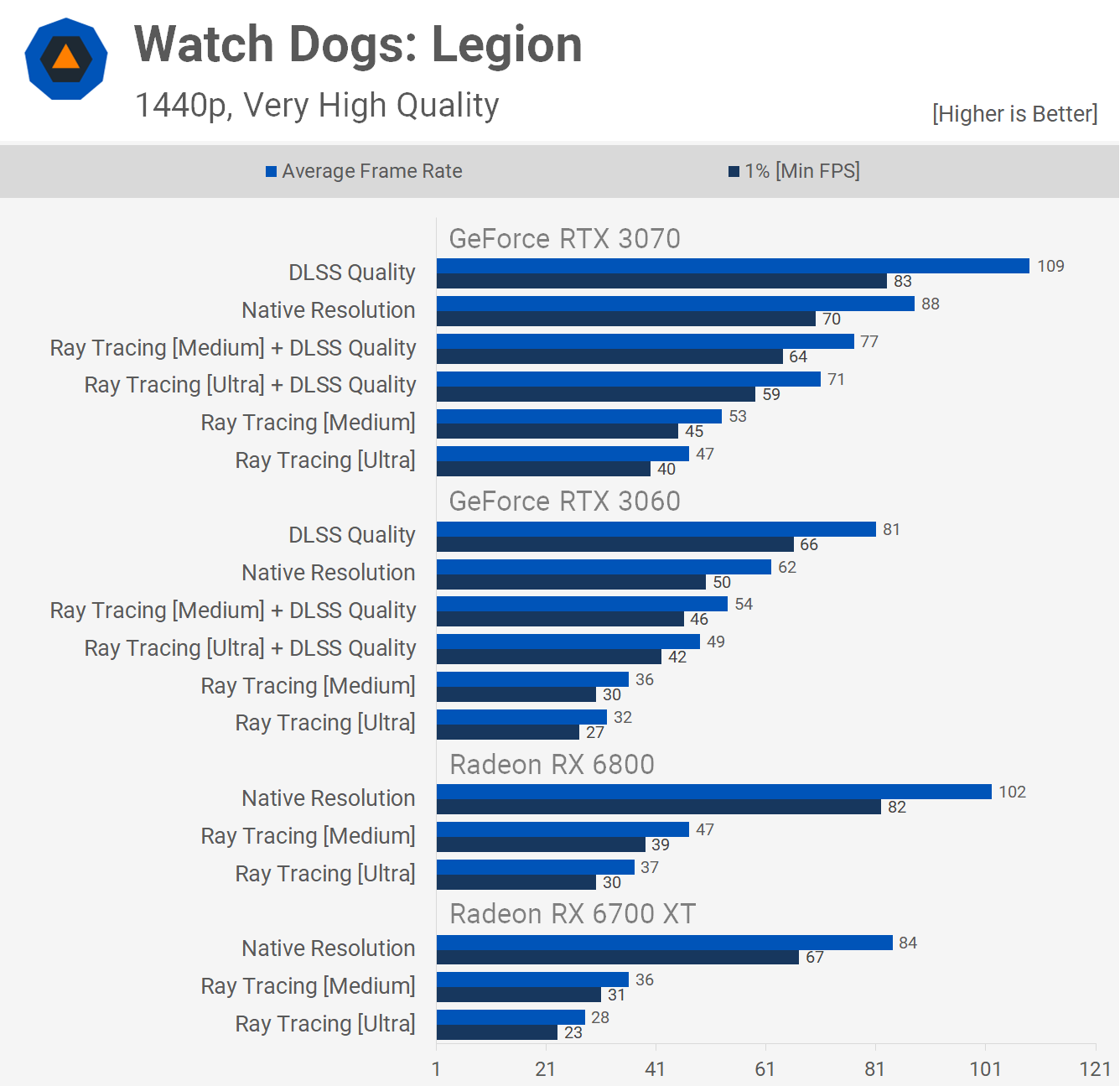
Using the medium quality RT effects the 6700 XT averaged just 36 fps, down from 84 fps without RT enabled. This is the same level of RT performance you’ll receive from the RTX 3060 in this title, at least without the aid of DLSS. Enabling DLSS boosted the 3060’s performance by 50% and therefore made it 50% faster than the 6700 XT.
Of course, we’re only talking about the RTX 3060 here. The real competitor is the RTX 3070 and in this title, it’s 47% faster without DLSS, 114% faster with DLSS. So if you care about ray tracing, you’ll want a GeForce 30 series GPU.
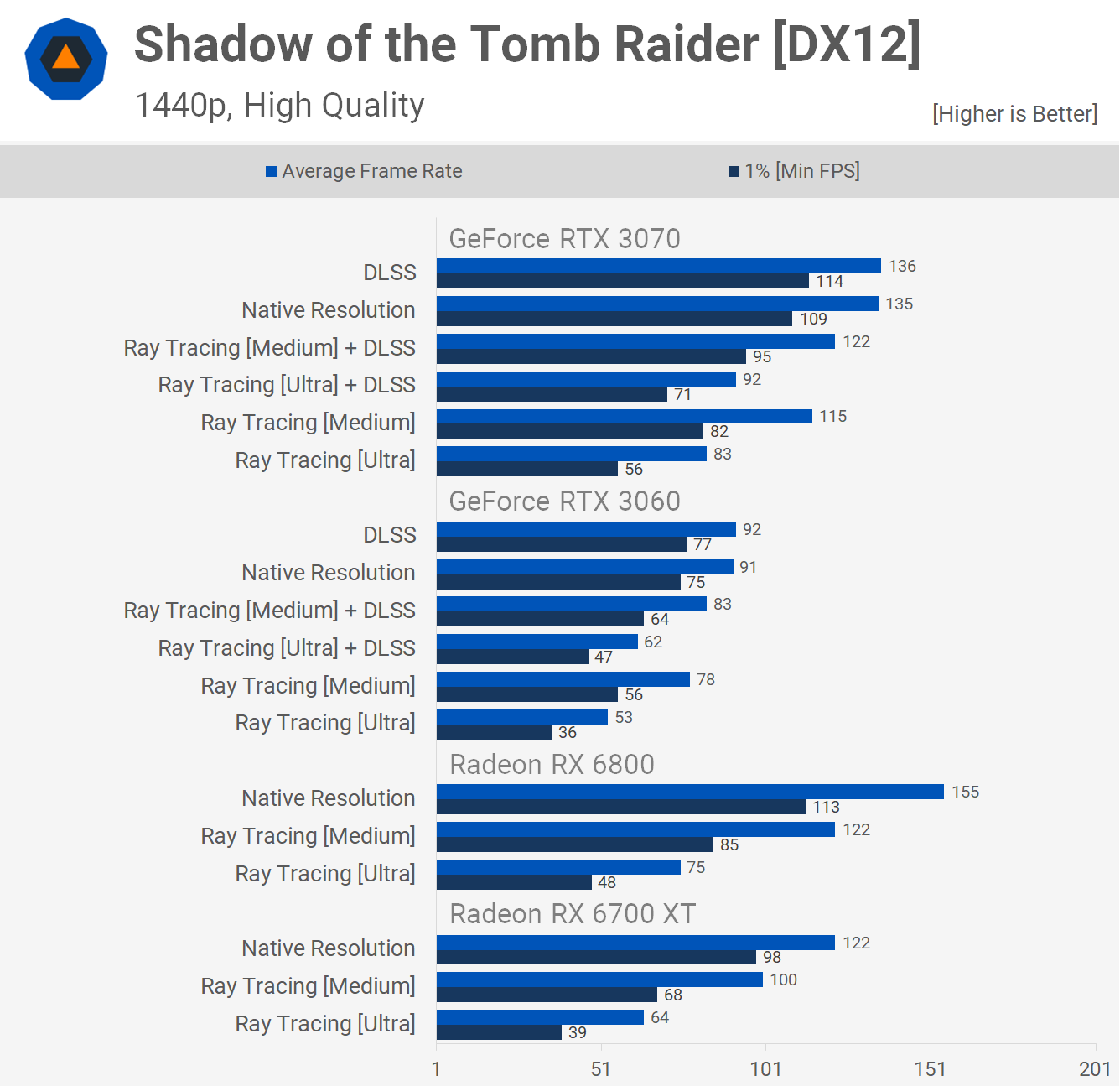
Ray tracing performance in Shadow of the Tomb Raider is much better, though we’re only using RT to enhance shadows, so it’s rather pointless in our opinion. Anyway, using the ultra quality setting the 6700 XT manages 64 fps on average, or 23% slower than the RTX 3070 and 30% slower with DLSS enabled.
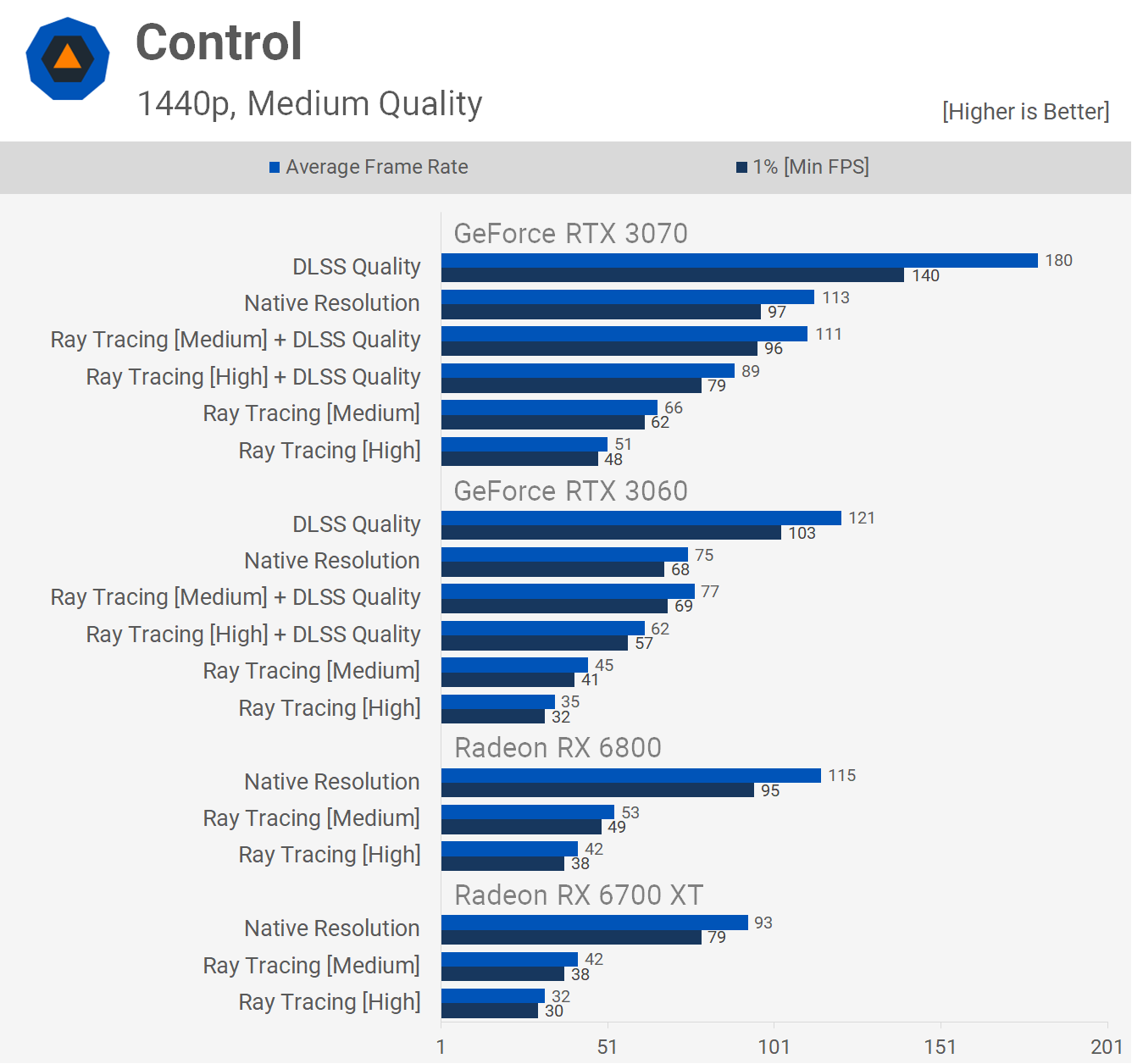
Finally we take a look at Control, where the RTX 3070 destroys the 6700 XT with RT enabled. For rasterization performance, the 3070 is already well in front, beating the 6700 XT by a 22% margin. That figure balloons to a 58% margin with RT set to high, and then 178% with DLSS enabled (!).
Resizable BAR
We’re not going deep into SAM-related testing as we’ve already provided in-depth benchmark coverage of this feature with the RX 6800 and scaling won’t be that different with the 6700 XT.
One of the best examples with the 6800 was seen in Assassin’s Creed Valhalla and here we’re looking at a healthy 12% performance boost, which allows the 6700 XT to match the 6800 without SAM enabled.
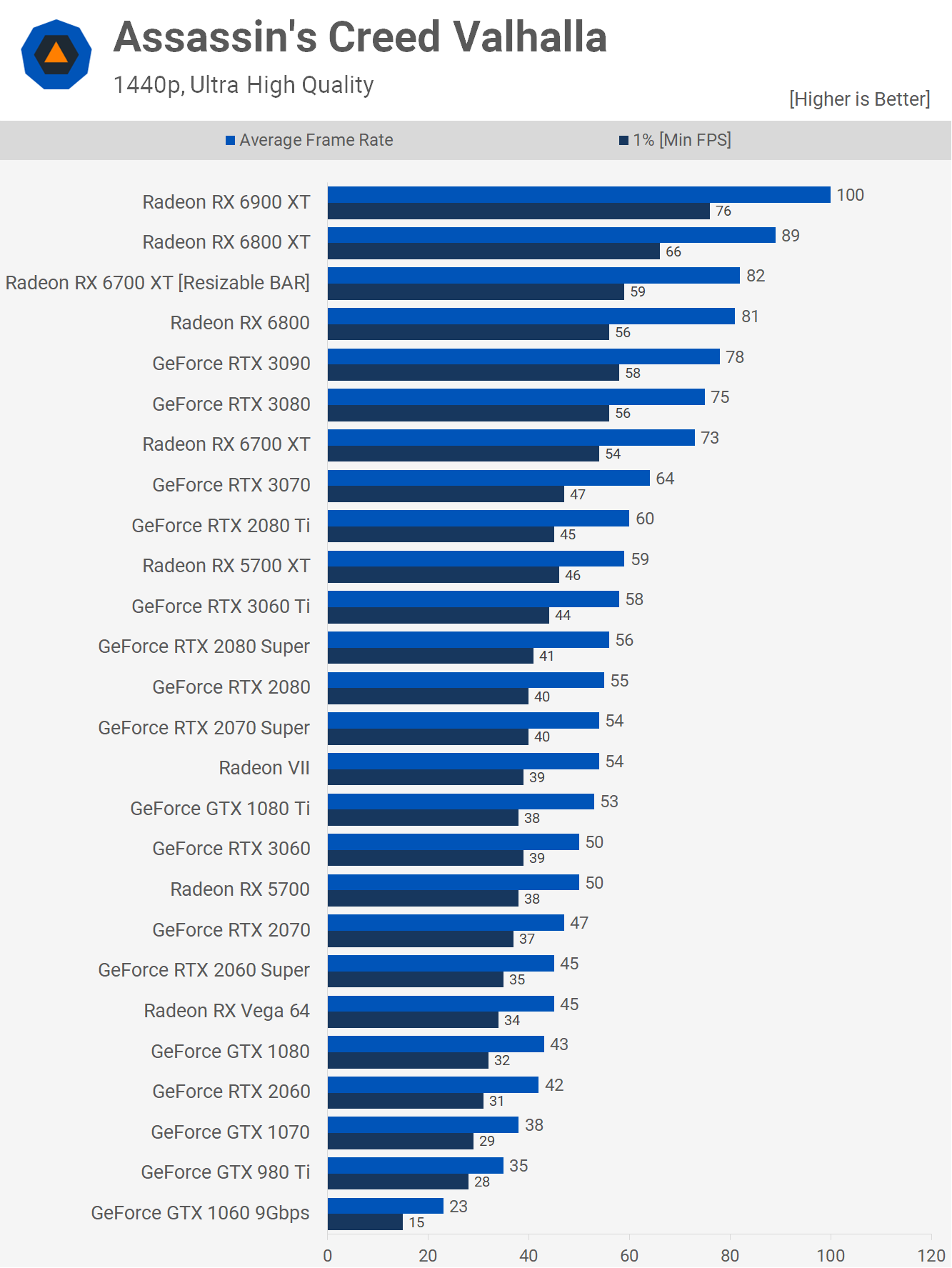
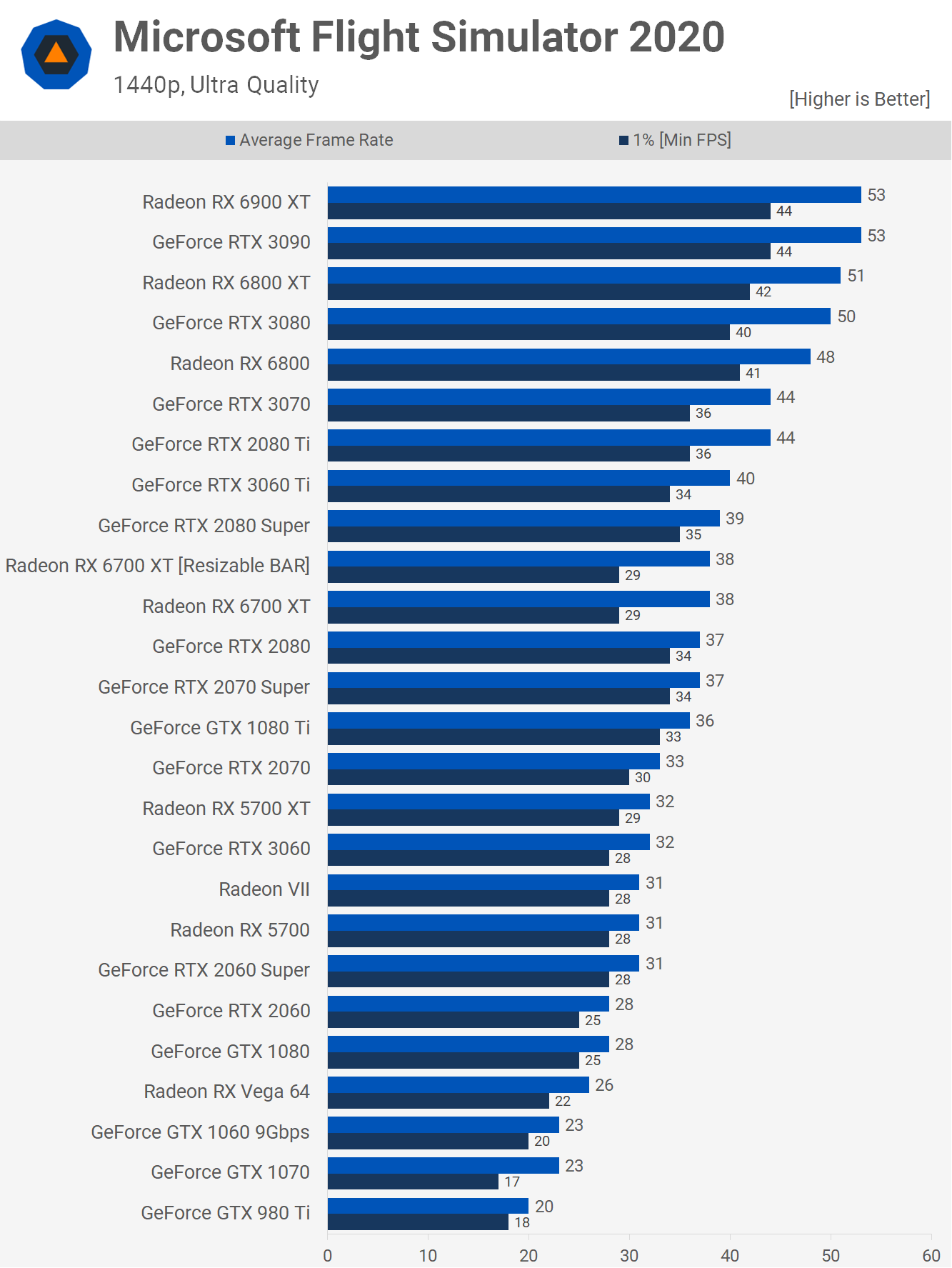
But as we found previously, SAM doesn’t work in all games and Assassin’s Creed Valhalla should be considered a best-case scenario. In Flight Simulator 2020, like many other games we see little to no performance improvement.
Power Consumption
Using PCAT to measure the power draw of just the graphics card we find that the 6700 XT is comparable to the RTX 3070, sucking down 221 watts, basically the same kind of power consumption you’d see with an RTX 2070 Super. It’s also 12% less power than the 5700 XT which is impressive given performance in this title was boosted by 30%.
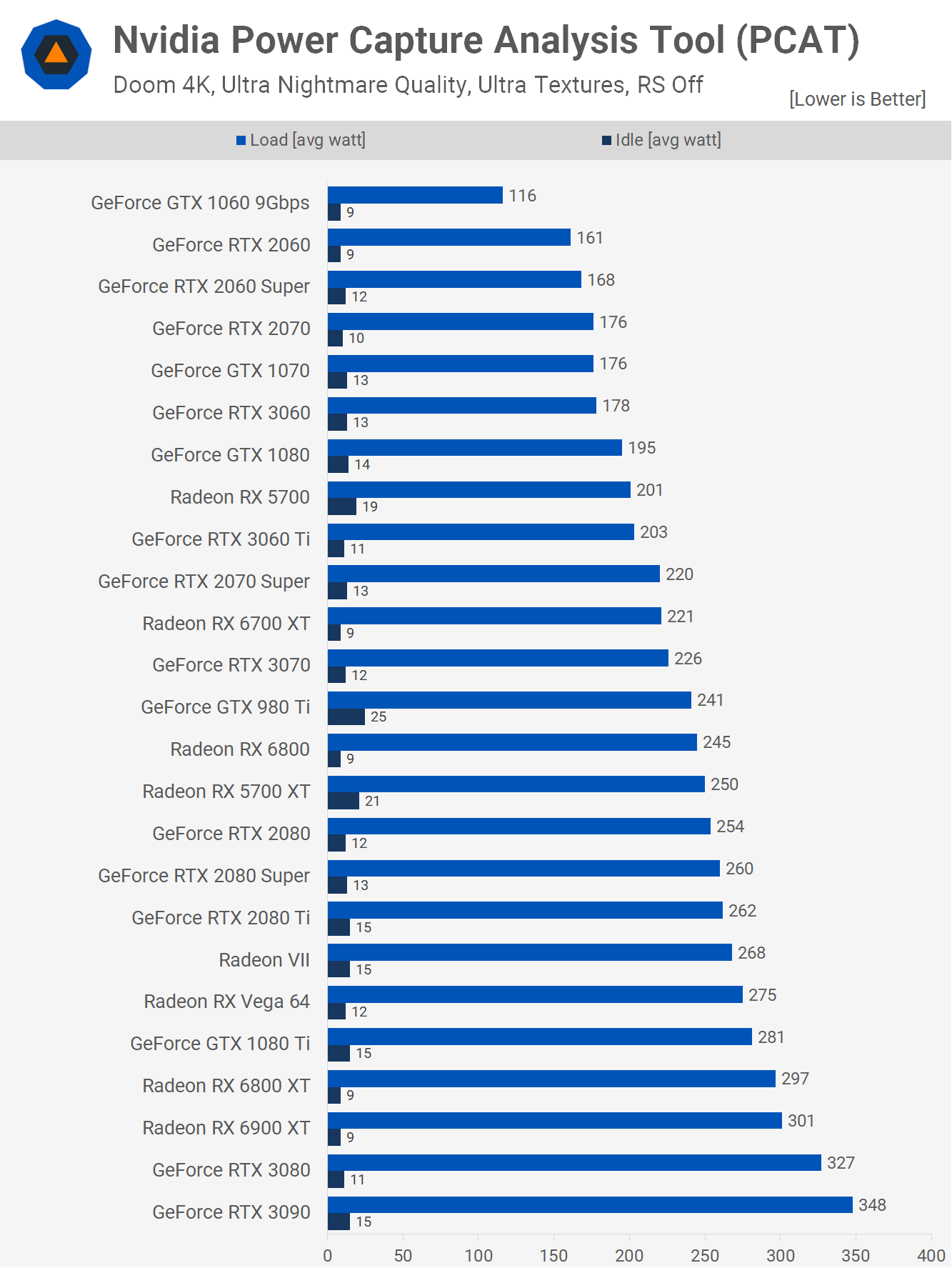
Overclocking
Using the AMD reference model, I was able to overclock the cores to 2.75 GHz and this resulted in a mild 6% performance increase. Remember this model is already clocked much higher than the 6800, which reduces the available OC headroom. It also means the RTX 3070 will typically extract a little more performance when manually overclocked, so for some of you that can help boost its value rating.

AIB Cards, Temps & Clocks
Ahead of this launch, we ended up with half a dozen AIB cards, so we’re going to look at the peak GPU hotspot temperature after half an hour of gameplay in an enclosed ATX case (we used the Corsair Obsidian 500D). This is stock, out of the box performance as I didn’t have time for noise normalized testing, dialing in each card takes quite a bit of time.
The highest clocking models were the Gigabyte Gaming OC and XFX Speedster Merc 319 and of the two, the XFX was far more impressive, operating its fans at just 1000 RPM for a hotspot temperature of 85C. The Gigabyte model was 2 degrees cooler, but you’re looking at almost twice the fan speed which increases the operating volume quite drastically. The Gaming OC should be a fair bit cheaper though, so it could still represent better value.
The PowerColor Red Devil and Hellhound models were very impressive, both ran the fans at 1000 RPM for sub 80C temperatures. The Red Devil clocked around 100 MHz higher and that made it one of the best models we tested.
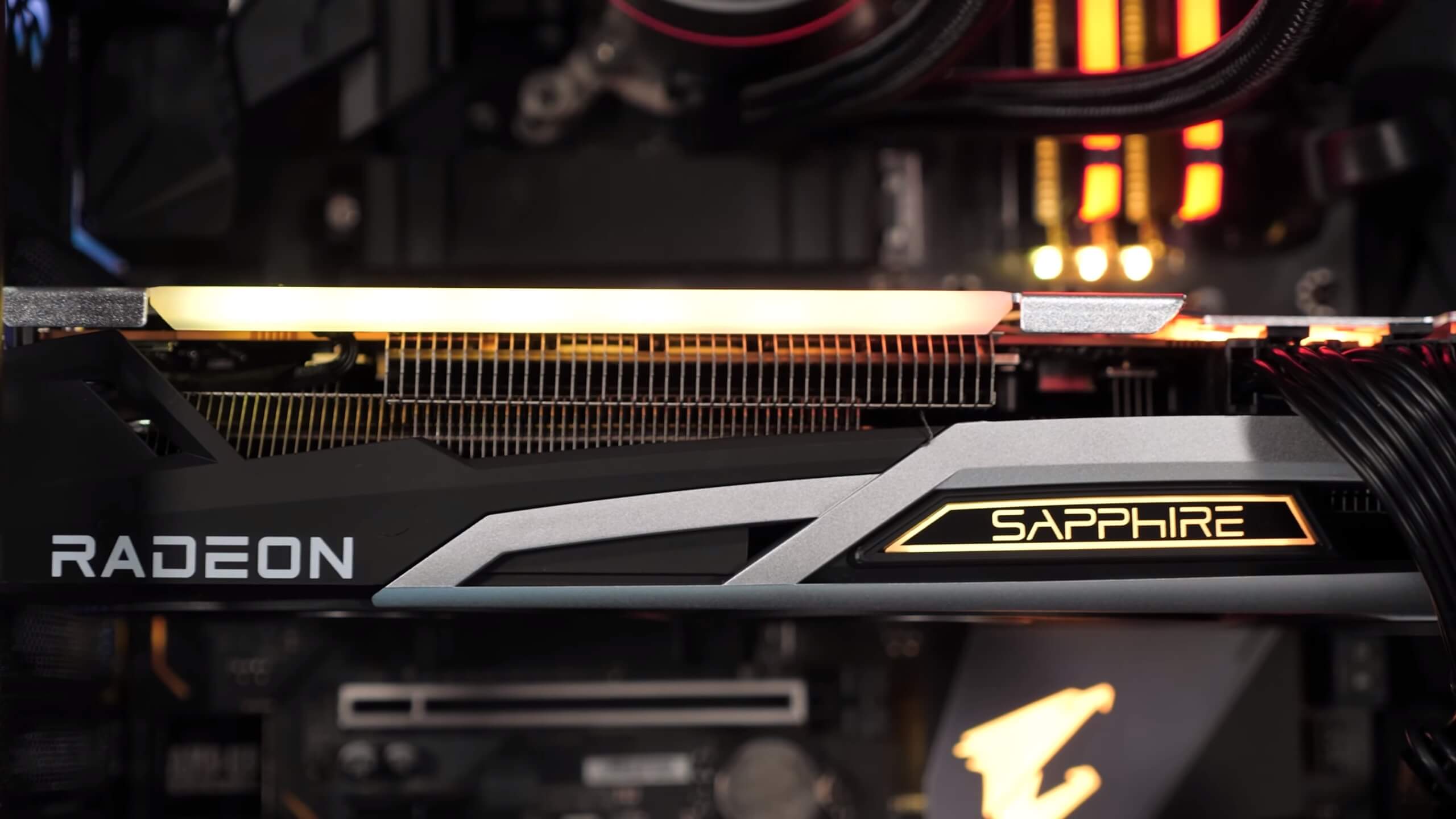
Sapphire’s Nitro+ almost forgot it had fans, spinning them at just 800 RPM after 30 mins of load. This model also appeared to sip power despite running the cores at 2.5 GHz. The hotspot temp creeped up to 91C, though that’s not bad given the whisper quiet fan speed.
The MSI Gaming X was one of the least impressive models and we suspect it would be comparable to the Gigabyte Gaming OC under noise normalized test conditions. It was quite a bit better than the AMD reference design though, so there’s that.
What We Learned
It’s hard to build a solid conclusion around the Radeon RX 6700 XT without really knowing what pricing and availability is going to look like. AMD claims a significant improvement in terms of availability than other recent Radeon launches, but that could just mean they’ve got a few dozen cards ready to sell.
In all seriousness, we have reached out to a few retailers and it does sound like they’ve got a decent amount of GPUs to sell this time. I suspect it still won’t be enough to meet demand, so expect them to still sell out quickly, but we’re starting from a healthier number. Assuming that’s the case and cards keep flowing over the coming weeks and months, that’s a positive. As for pricing, we’ll have to see, but the target is that these cards will sell for less than RTX 3070s.
Now, putting availability and inflated pricing aside for a moment, let’s assume we’re living in more normal times. So the 6700 XT will hit shelves today, quickly sell out at the MSRP and then supply should catch up a few weeks down the track… at which point you can easily buy one at the $480 MSRP (or your local equivalent).
In that reality, the Radeon 6700 XT is a pretty lukewarm product. It’s a very small improvement from its predecessor in terms of value. You do get a bit more VRAM, and efficiency has been greatly improved, but overall a 30% performance increase at a 20% price premium is hardly cause for celebration.
It’s roughly equal to the GeForce RTX 3070 in terms of value, too. But as we’ve discussed in the past, it’s not good enough for AMD to simply match Nvidia in terms of cost per frame as there’s more to the value equation. For example, Radeon GPUs lack the same level of ray tracing maturity. We’re still waiting on a DLSS competitor, which is becoming more and more of a big deal as the game support list for DLSS continues to grow. Also, for streamers the Nvidia encoder is much better.
So even if we accept that GPUs released in 2021 won’t necessarily stack up as well as we’d like in terms of value compared to models released in previous years due to external factors that include the ongoing trade war, increased logistics/manufacturing costs and mining demand — all of which result in products being more expensive than they were just a few years ago — it’s still hard to accept the 6700 XT at $480. Given the missing features we just mentioned, I feel the 6700 XT needs to be at the very least $50 less expensive than the RTX 3070.
However, the reality is that it makes little sense for either AMD of Nvidia to release a good value GPU right now. Both are selling everything they can produce and therefore the incentive for AMD to heavily undercut Nvidia just isn’t there. So instead they’ve essentially priced-matched the RTX 3070. But if I had my choice of the RTX 3070 for $500 or the 6700 XT for $480, I would go with the GeForce GPU. A tiny discount is no incentive to miss DLSS, especially because I play a lot of Fortnite.
As for the six AIB models we have on hand, they all worked very well, my personal favorites were the PowerColor Red Devil and XFX Speedster Merc 319, though I suspect they will both be rather pricey, especially the XFX model. The PowerColor Hellhound was also excellent and if they can deliver that near the MSPR, once things return to normal, then that will be one to look out for.
The Sapphire Nitro+ is too quiet for its own good and I suspect it will perform well relative to the PowerColor and XFX models once noise normalized, though again I don’t expect it to be cheap. The Gigabyte Gaming OC should be good value and while the cooling performance wasn’t amazing given the high fan speed, it’s certainly acceptable.
The MSI Gaming X is expected to be a premium model, there will no doubt be a Ventus or something cheaper, so I assume this is going up against the likes of Sapphire’s Nitro+, XFX’s Merc and PowerColor’s Red Devil and I hate to say it, but the Gaming X just doesn’t seem to be in quite the same league. That said the performance was perfectly acceptable so if the price is right this will be another model to look out for.
And that’s going to do it for this review, let us know what you think about this new GPU and if you’re able to score any new Radeon or GeForce cards at a decent price.
Shopping Shortcuts:
[ad_2]
Source link
